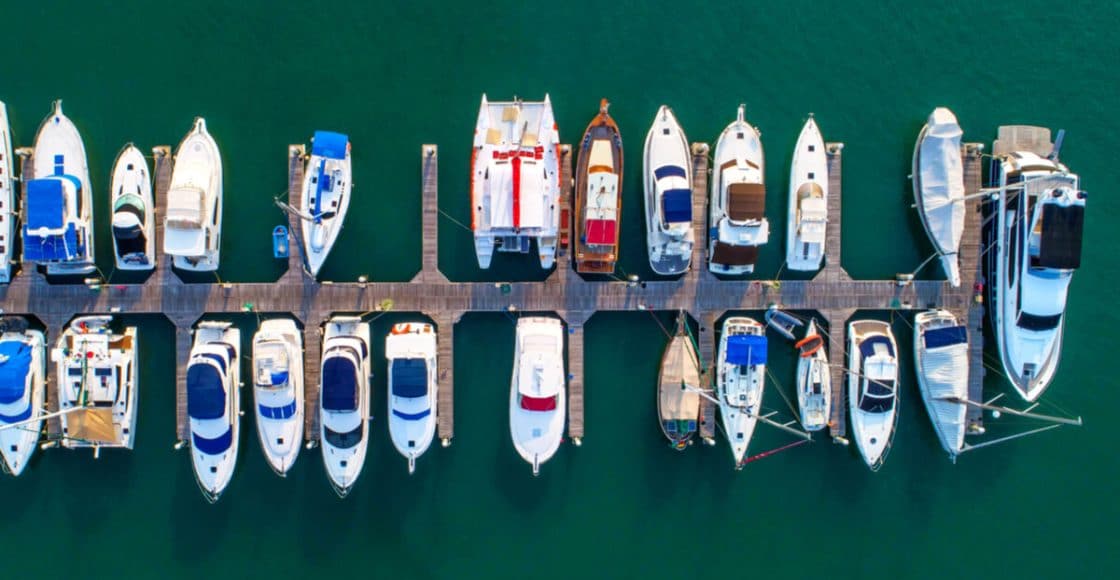

Yachts vs. Boats: What are the Differences?

Table of Contents
Last Updated on April 13, 2022 by Boatsetter Team
Many people use the words “boat” and “yacht” interchangeably, and some lean on the latter to make their ride sound more impressive. But what are the key differences between boats and yachts?
First, let’s look at some broad definitions of a boat, a yacht, and other related vessels.
- “Boat” can refer to just about any kind of vessel— towboat , fishing boat , center console , houseboat , and so on.
- “Dinghy” designates a small boat with a human or wind means of propulsion including a rowing dinghy or sailing dinghy. It also refers to a tender to a bigger boat or yacht.
- “Ship” is a large commercial boat, often used for distance travel and transport of goods or passengers – cruise ship, container ship, etc.
- “Yacht” is typically a larger boat with luxury amenities used as a recreational vessel— motor yacht , sailing yacht .
- “Superyacht” is a large yacht and is often also called a mega yacht . The delineation used to be at 80-feet but again, with today’s size creep, anything under 100 feet would just simply be called a yacht.
So, yacht or boat? Let’s dive deeper into the elements that differentiate a boat from a yacht.
Own a Boat or a Yacht? Learn How to Offset the Cost of Ownership by Listing on Boatsetter
Size of the Vessel
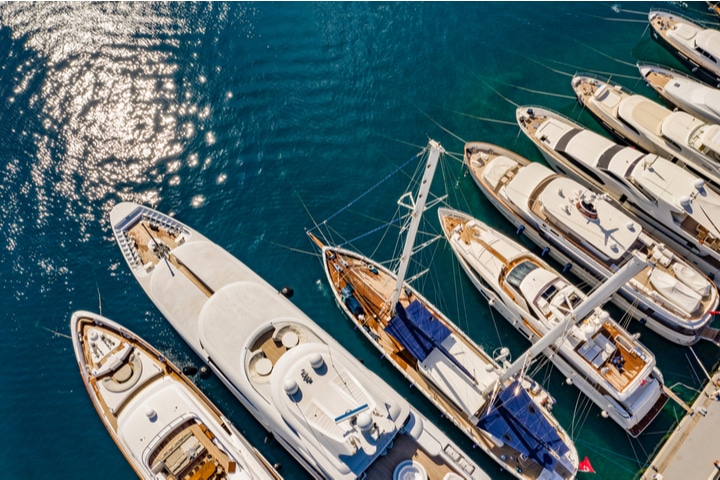
Some place a hard line at 35 feet. Below that, you have a boat and above, it’s a yacht. However, that’s an artificial differentiator.
Just 30 years ago, a 30-foot boat was considered large and could have been a yacht but as recreational boats grow longer, the term yacht has been pushed up the scale.
That said, a well-kept 40-foot boat designed for recreation can technically still be called a yacht (although larger vessels are likely to cost more, price isn’t a good indicator of yacht status primarily because it fluctuates with brand, age, and amenities).
Check out local yacht rentals near you to understand how size plays a difference.
What it’s Used For
A yacht is a vessel designed for recreational purposes. It generally operates on open waters (rather than small lakes or rivers) and has accommodations for overnight guests.
A cruise ship, on the other hand, accommodates a large number of passengers in a commercial setting whereas a yacht carries a smaller number (of paying or non-paying) passengers for private recreation.
Onboard Technology
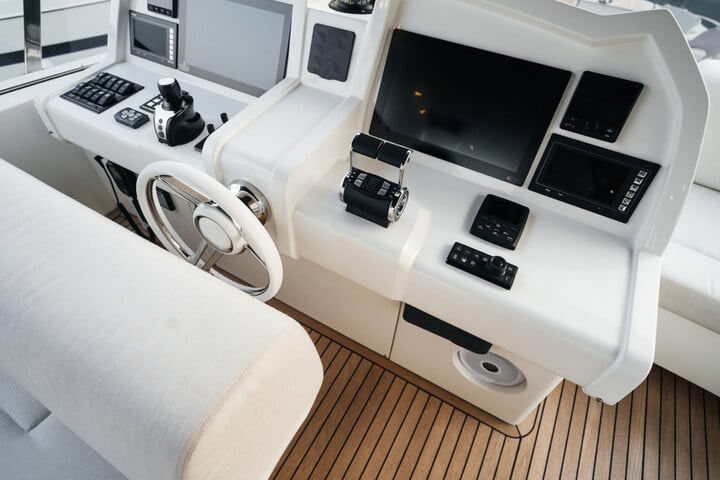
Advanced technology for navigation, communications, and system operation as well as redundant systems for safety can be found on a yacht that is likely to venture farther.
Again, there are caveats because today’s towboats that are fun day boats also feature technology such as GPS and digital switching that integrates many electrical and electronic features.
Propulsion Types
This is a tricky one. “Yacht” comes from the Dutch word “jaght” which referred to a sailing vessel that was used by the navy to capture pirate ships and later for recreation by the affluent.
Today, a yacht can be a large sailing vessel or a motor yacht. All larger yachts will have a motor for propulsion whether they have sails or not. Sailboats by design have smaller motors so trying to put a horsepower minimum on yacht propulsion is simply inaccurate.
Some define a yacht as having multiple crews to operate the vessel and tend to passengers or guests. The larger the yacht, the more crew will be required to navigate, maintain and service the vessel. That said, a couple who owns a 50-footer can call their boat a yacht although it’s owner-operated.
Luxury and Amenities
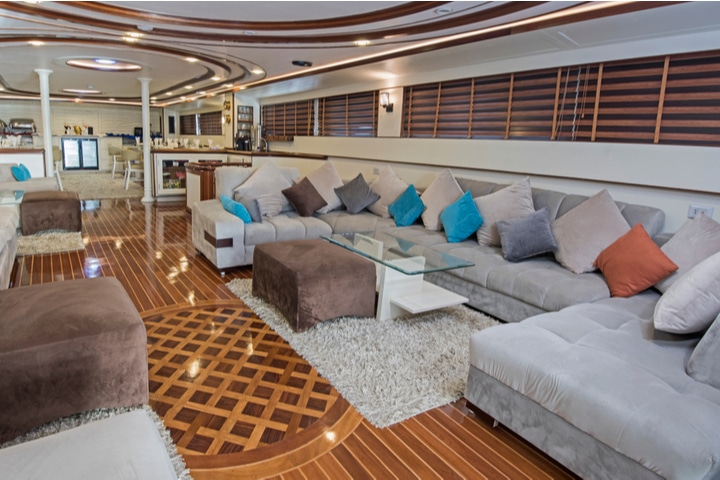
This is perhaps the best measure of a yacht. If the vessel offers accommodations, a galley , a head , and is luxurious in its presentation, it’s most likely a yacht.
That said, there are lots of center console fishing boats and towboats that are pretty nicely equipped these days and they wouldn’t be called a yacht.
All yachts are boats, but not all boats are yachts—and the lines are blurry. The word yacht elicits images of posh seafaring experiences while a boat evokes ideas of fun and perhaps work. Do some research to learn what size and type of boat or yacht is best for you .
To a degree, the point at which a boat becomes a yacht is in the ear of the beholder but if you focus on size, amenities, and the type of use, you’ll be able to discern the difference. Then all that remains is to find a way to spend time and have fun on any kind of vessel.
Browse All Available Boat & Yacht Rentals Across the Globe

Zuzana Prochazka is an award-winning freelance journalist and photographer with regular contributions to more than a dozen sailing and powerboating magazines and online publications including Southern Boating, SEA, Latitudes & Attitudes and SAIL. She is SAIL magazines Charter Editor and the Executive Director of Boating Writers International. Zuzana serves as judge for SAIL’s Best Boats awards and for Europe’s Best of Boats in Berlin.
A USCG 100 Ton Master, Zuzana founded and manages a flotilla charter organization called Zescapes that takes guests adventure sailing at destinations worldwide.
Zuzana has lived in Europe, Africa and the United States and has traveled extensively in South America, the islands of the South Pacific and Mexico.
Browse by experience

Explore articles
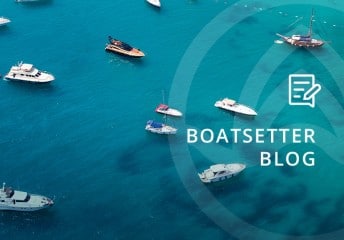
Everything You Need to Know about Lake Lanier Boating
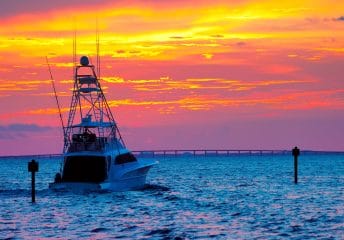
Destin, FL Fishing Guide

Marinas on Lake Pleasant, Arizona

Haulover Sandbar Boating Guide
- Pontoon Boats
- Personal Watercraft
- nauticalknowhow
- Nautical Knots
- Tools and Calculators
Yacht vs Boat: What’s the Difference?
You may be surprised to learn that the difference between a yacht and a typical boat is not as easy to figure out as you’d think. This is thanks to the fact that there’s no specific definition for what a yacht actually is. In general, and as most people commonly use and understand these words, a yacht is a fast, often luxurious vessel used for recreational purposes. A boat, on the other hand, is typically a smaller vessel and it can have many purposes from recreation to fishing to rescue and more.
Let’s get into some of the specific differences between yachts and boats to get a better idea of what each of these admittedly general terms is trying to refer to.
What is a Yacht?
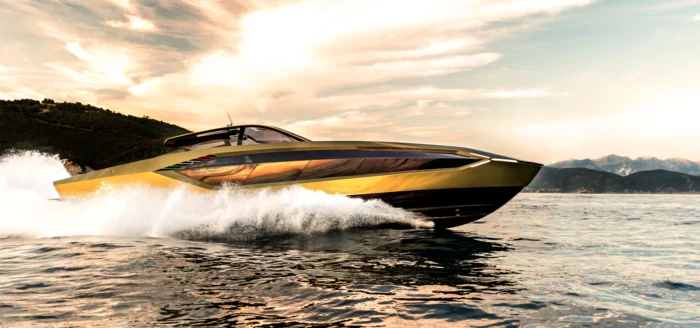
Yacht comes from a Dutch word jaghte , itself from the word jaghtschip which means “fast pirate ship.” That gives you an idea of where people’s heads were at when yachts first came on the scene. These days, the pirate part isn’t really involved but you do tend to expect a yacht to have some speed. Not that these are necessarily speed boats all the time, but there are racing yachts out there that people use exclusively for that purpose.
Because there is no specific definition for the word yacht in modern usage, you have to play it by ear a little bit. It’s one of those words that we all know what it means, even if we don’t have a proper, set in stone definition.
In general, and for most people, a yacht is a large recreational boat, capable of reaching high speeds and noted for its luxury and features. So what does any of that mean?
In terms of size, most people but not all would consider a yacht to be a boat that has reached at least 78 feet. Some people would acknowledge smaller vessels, as low as even 33 feet, as yachts, but this can be hotly debated even among yacht makers and yacht charter companies.
What is a Boat?

One of the oldest words in any language, boat can be traced back through Middle English to Olde English to proto-Germanic to the proto-IndoEuropean word “bheid” where it may have originally meant “to split” or something along those lines. That would have referred to simply splitting or hollowing wood to make a boat. So, by that definition, a boat is incredibly loosely defined.
In modern understanding a yacht is a boat but not all boats are yachts. Consider boat more of an overarching term like automobile while yacht is like an SUV. There are lots of other automobiles and SUV is just one kind.
Usually when people talk about boats today they mean smaller vessels. At some point, large boats become ships, and potentially even a yacht. Smaller boats could be anything from a fishing boat to a jon boat to a sailboat , a bass boat , catamaran , pontoon boat and more. Those boats often have very different forms and functions which allow for a heck of a lot of variety and usage.
Yacht Size vs Boat Size
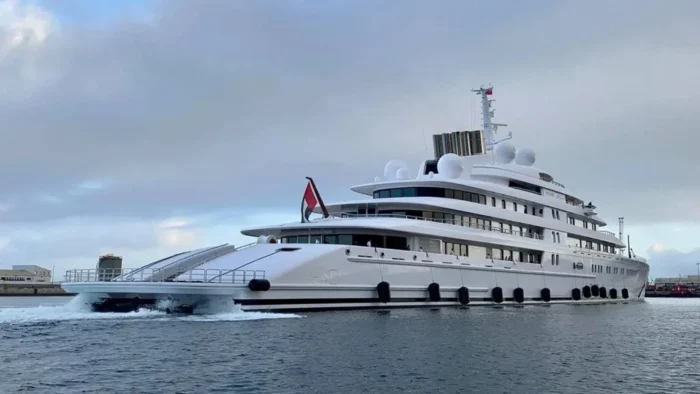
As we mentioned above, people have different opinions about how big a yacht has to be. The bare minimum seems to be at least 33 feet. That said,I have even seen smaller boats called yachts but let’s say, at a minimum, any vessel under 30 feet will always be a boat of some kind and would rarely if ever be properly called a yacht.
Larger boats exist and are not yachts, of course, but these can be sport fishing boats, catamarans, even large pontoons, houseboats and more.
Yachts can start at that low range and get up to incredible sizes which we will touch on in a moment. The largest yachts can get close to 600 feet.
Mega Yachts vs Larger Boats

Once a yacht hits 120 feet people often call it a super yacht. There doesn’t seem to be an easy to find historical reason why 120 feet is the cut off that makes a super yacht. As yachts grew even larger, 200 feet became a sort of milestone for where a superyacht became a mega yacht. And nowadays, with even bigger yachts available, 400 feet is where the cut off often begins for yachts known as gigayachts.
Now, when it comes to large boats, here’s where things get fuzzy. You can find sport fishing boats that are over 120 feet, or sailboats that reach the same length and much bigger. But these are often also called yachts. Sailing yachts, sport fishing yachts. So there’s a line there that boats can straddle even if, under a certain length, the same boats wouldn’t be considered yachts.
Part of the transition from boat to yacht at large sizes comes from the fact that a massive boat is obviously expensive which means more luxury features are likely to be included which means it’s more likely to be considered a yacht.
But large commercial vessels, military and law enforcement vessels, and some search and rescue vessels used by government agencies or private companies can also reach lengths of 60 feet to 100 feet and more and these would obviously never be called yachts. It’s that key feature of being used for recreation that you need to factor in.
Yacht Engines vs Boat Engines
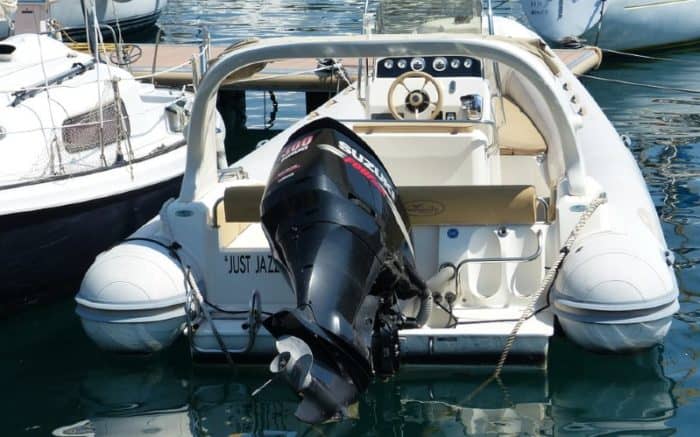
Obviously a sailing yacht won’t factor in here but motor yachts and hybrid yachts have very powerful engines because yachts tend to have a much higher gross tonnage than your average boat of even the same length. Keep in mind that some yachts, especially mega yachts, may have up to seven decks. You need a lot of power to keep that moving. Some of the biggest yachts in the world have a fuel tank capable of holding up to a million liters. That’s going to leave your normal outboard motors in the dust.
Boat Crew vs Yacht Crew

Yacht crews are often found wearing uniforms and have specialized training not just to run the vessel but also to see to the needs of the guests. Since yachts are often characters, the guests on board are like guests at a hotel and treated as such. Large yachts are a lot like a private cruise service.
Boats don’t always even need a crew and if a boat does have a crew it probably means the boat is a commercial vessel of some kind – think of a commercial fishing boat, for instance.
Boat Amenities vs Yacht Amenities

Here’s a place where boats and yachts often part ways significantly. There are some pretty luxurious houseboats and pontoons and cabin cruisers out there to be sure, but when you look at what you can get on a megayacht there’s barely a comparison.
The most expensive yachts have multiple helipads, swimming pools, tender garages that contain things like jet skis, gyms, high tech yacht electronics, massage rooms, bars, movie theaters, mini subs, discos, you name it. These really are like private cruise ships.
Now obviously it’s not fair to compare a 12 foot jon boat to the 600 foot Azzam yacht but these are clearly as different from each other as any two things can be. Yachts are known for their luxury and they can truly push the limits sometimes.
Yacht Locations vs Boat Locations

Smaller boats are obviously more capable of handling coastal and inland waters than any yacht you’re likely to find because that’s what they’re meant for. Yachts are typically, but not always, found in saltwater, usually around vacation destination areas like the Bahamas, the Mediterranean, Florida, tropical islands and so on. Boats are at home anywhere you find water.
There are definitely yachts on inland lakes like the Great Lakes, but they are decidedly less common.
Yacht Price vs Boat Price
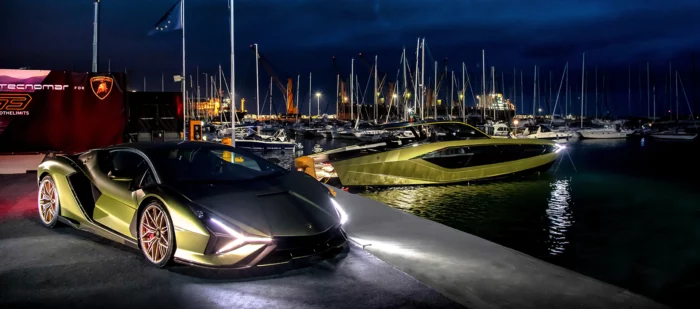
Here’s where things get really different. You can get a little fishing boat for a few hundred dollars if you want. The Eclipse yacht cost $1.5 billion. So that’s the range we’re dealing with in terms of yachts vs boats when it comes to cost. If you try to meet in the middle with a 33 foot sport cruiser boat you might pay $200,000. But the average price for a yacht in 2021, and this means a vessel between 56 feet and 79 feet, was $1.1 million.
The Bottom Line
All yachts are boats but not all boats are yachts. In general, a yacht is a larger vessel that is used strictly for recreational purposes. It’s defined by its speed and its luxury and is often at the higher end of the price range. You tend to find yachts in popular vacation spots and they come in at an average price over $1 million.
Boats are generally smaller vessels and can be used for everything from fishing to cruising to commercial, police boats and military purposes. They can be extremely simple and, as a result, also incredibly cheap compared to yachts as well.
My grandfather first took me fishing when I was too young to actually hold up a rod on my own. As an avid camper, hiker, and nature enthusiast I'm always looking for a new adventure.
Categories : Boats , Yachts
Leave a Reply Cancel reply
Your email address will not be published. Required fields are marked *
Save my name, email, and website in this browser for the next time I comment.
More in Boats

What Is A Gunwale?

131 of the Best Hawaiian Boat Names

167 Patriotic Boat Names

The 138 Best Boat Names for Dog Lovers

The People’s Poncho Review and Ratings

Oru Lake Kayak Review

About Boatsafe
Established in 1998, BoatSafe is your independent guide into the world of boating, fishing, and watersports. We provide expert insights and detailed guides to help you find products tailored to your needs and budget.
Contact Boatsafe
- Address: 4021 West Walnut Street. Rogers, AR 72756
- Phone: (479)339-4795
- Email: [email protected]
Site Navigation
- How We Test
- Corrections Policy
- Privacy Policy
- Terms & Conditions
- Editorial Policy
- Affiliate Disclosure
Our Reviews

All content is © Copyright 2024. All rights reserved.
Click on the button to load the content from www.googletagmanager.com.
Load content

- Tailored Vacation Planner
- Cabin Yacht Charter
- Family Sailing Holidays
- Romantic Sailing Vacations For Couples
- Sailing with friends
- Greece all inclusive yacht charter
- Croatia all inclusive yacht charter
- Food & Wine Routes
- Yacht search
- Luxury sailing
Boat vs. Ship vs Yacht: What’s the Difference?
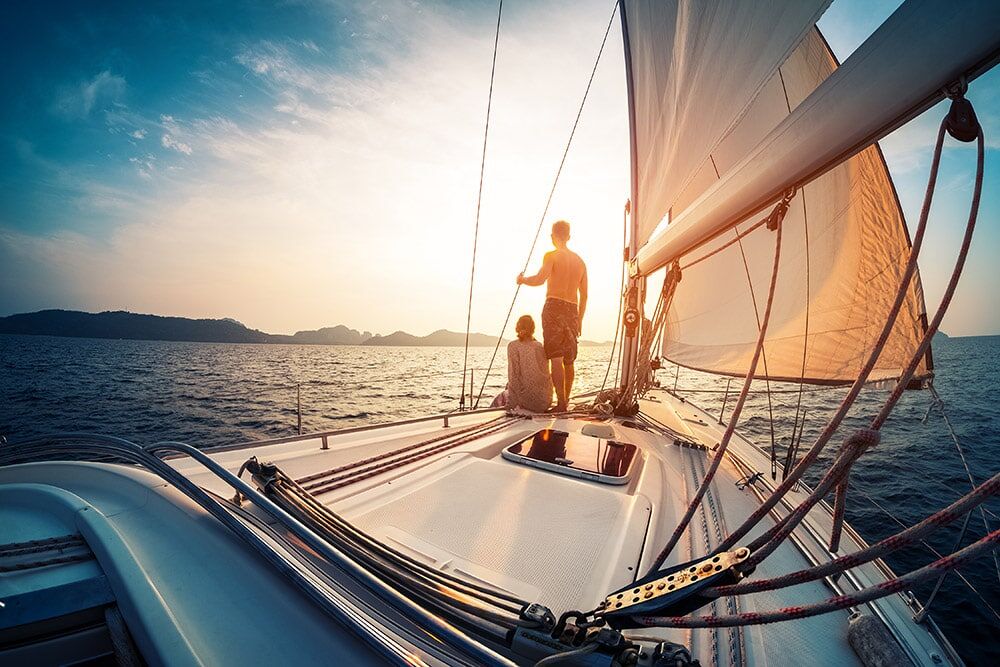
Language is a tricky thing, and picking out the differences between similar terms can be confusing. This is especially true when some of the definitions overlap. This is the case with the case of boat vs. ship vs. yacht . What’s the difference? We know in our gut that there are differences between these three seafaring vessels, but unless you’re a harbor master do you really know what counts as what?
Let’s get into some definitions, and we’re going to start with the easiest to explain: What is a yacht? What is a ship? And what is a boat?
Yacht vs. Ship vs. Boat
What is a yacht.
A yacht, I think everyone would agree, is fancier than a ship or a boat. “Yacht” infers some amount of luxury , and definitely recreation. There’s also something to be said about size. A yacht tends to be anywhere between 35 feet up to 160 feet. And some yachts, known as superyachts, go even beyond that. (Jeff Bezos just built a 417 foot yacht, but that’s really breaking yacht records.)
Because of the size, yachts tend to operate in larger bodies of water–generally the ocean. Yachts are able to handle rougher ocean waves, and they are also equipped with more advanced navigation and guidance instruments than smaller boats. Likewise, a yacht tends to have a full crew to help with the navigation, engineering, repairs, as well as having stewards that serve the yacht’s guests. This can be anywhere from a crew of four or five up to a crew of a few dozen on large yachts.
One interesting thing to note is that outside of the United States, a yacht refers to a sailboat , and a motorized yacht is called a “motor yacht”.
So, is a yacht a boat? Yes, technically a yacht is a boat. But a yacht is a very specific kind of boat.
Want to hop aboard?
Book your dream sailing vacation in top sailing destinations!
- Explore your charter options
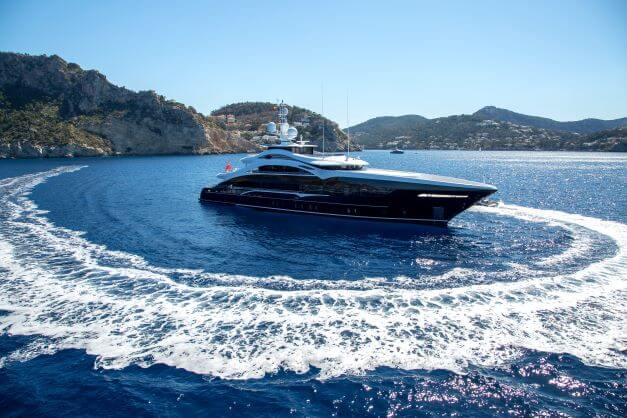
What is a Ship?
The term ship is most commonly associated with a very large boat, and something that is not as fancy as a yacht (one exception is that cruise ships can still be very fancy, but are referred to as ships because of their size and power.)
Ships are generally so large that they would never be found in a lake, with some exceptions for the Great Lakes, and are made for navigating the high seas of the open ocean. An ship can refer to a cruise ship, a naval ship, a tanker, a container ship, and many other commercial vessels.
Ships tend to have advanced navigation and technology, but much more advanced than that of a yacht due to the size, the speed, and the routes that a ship will take. They are meant to be traversing the open ocean for very long periods of time, from one continent to the next, while a yacht may only rarely set across the ocean and most often stays somewhat near land.
A ship will also have a much larger crew than a yacht or a boat. Ships are typically so large that they need not only one trained navigator but a set of navigators, plus an entire engineering team, and includes many more positions.
Finally, a ship is meant to carry things. This may be passengers, yes (in reference to cruise ships and some navy ships) but most ships are for carrying cargo–or even carrying equipment to do work on other ships including repair work or refueling.
What is a Boat?
Well, a boat is harder to define, because a yacht is technically a boat, and a ship is technically a boat. But when people refer to boats, they are almost always referring to something smaller than either a yacht or a ship. Boats may be motorized, like a speed boat, or they may sail, or they may be man-powered, like a rowboat or a kayak. Really, anything up to and including a liferaft, can be called a boat.
(As a side note that will just muddy the waters even further, submarine captains are adamant that their subs are boats. They are not ships.)
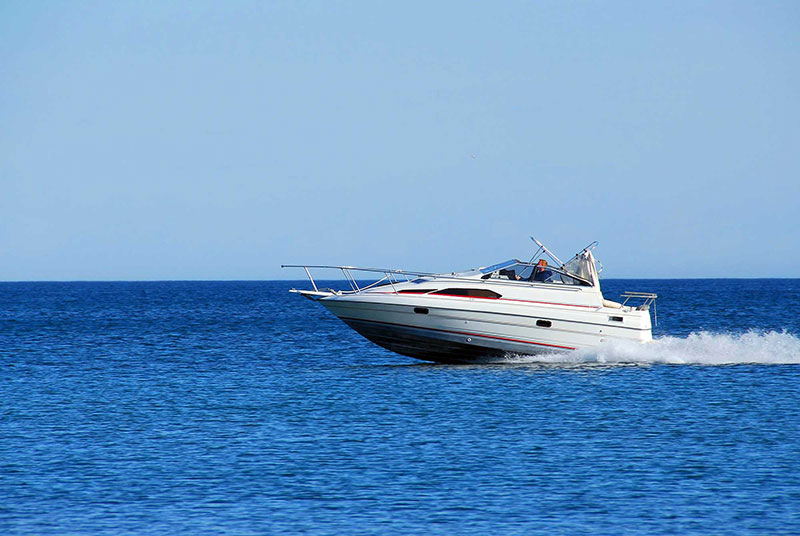
So, Boat vs. Ship Vs. Yacht?
Ultimately it comes down to this: all three of them are boats, but yachts are fancier, larger, and used for recreation, and ships are even larger, used commercially or by the navy, and are meant to cross oceans. The dividing line is sometimes thin, but generally speaking, when it comes to boats vs. ships.vs. yachts you can go by the adage “ I know it when I see it .”
Share article:
Have a question.
We have answers to your questions. So don’t hesitate to get in touch with our team today!
- GET MORE INFO
Feel free to ask us anything. All hands on deck. Let's sail
Thank you for sending us an inquiry, thank you so much for your enquiry.
- Anchoring & Mooring
- Boat Anatomy
- Boat Culture
- Boat Equipment
- Boat Safety
- Sailing Techniques
Yacht vs Boat: What is the Difference?
If you are new to the boating world, it is easy to get perplexed by the terminology. One question frequently emerges about defining and discerning the difference between a yacht vs boat. This is mainly because these terms have overlapping aspects.
However, there are clear-cut differences in size, functionality, luxury, etc. In this blog, we will unravel these differences and provide a comprehensive analysis and comparison of each other. This guide touches upon various aspects, including these vessels’ definition, design, amenities, crewing, and recreational uses.
Key Takeaways
- Yachts are generally larger and more luxurious than boats. A vessel typically becomes a yacht when it is over 33 feet long, although amenities and luxury also factor into this classification.
- Boats are often smaller and have a practical design. They are equipped with features directly related to their intended use, such as fishing or watersports.
- Both yachts and boats can offer a range of recreational activities. However, yachts are more about leisure and comfort, while boats are about specific recreational pursuits.
- Yachts usually require a crew to operate and utilize more sophisticated systems. Boats, on the other hand, can often be operated by a single person or a small group and may use simpler systems.
- Understanding when a boat is considered a yacht (and vice versa) is essential. The basic rule of thumb is that all yachts are boats, but not all boats are yachts. Size, luxury, and crew requirements contribute to a vessel's classification.
- Superyachts or megayachts are a whole new level of luxury. These vessels exceed 164 feet and feature an even higher level of luxury.
What is a Boat?
At the most fundamental level, a boat is a watercraft designed for transportation, whether for fishing, sport, travel, or even as a place of residence. Boats come in various designs and sizes – from small wooden canoes that can only fit a handful of people to large, motorized vessels designed for longer voyages across the sea.
There are many different types of boats, each suited for other uses. For fishing enthusiasts, there’s the fishing boat, equipped with specialized features like fishing rod holders and a trolling motor.
For those who value stability and space, the pontoon boat, with its flat deck and large, buoyant tubes, is an ideal choice. Sailboats, designed for propulsion primarily using sails, are for those who wish to harness the power of the wind for their seafaring adventures.
What is a Yacht?
You’re not far off if you hear the term ‘yacht’ and think of luxury and opulence. Originally derived from the Dutch word ‘jacht’, meaning ‘hunt’, the term was used to refer to fast, lightweight vessels that the Dutch navy utilized for chasing down pirates.
However, ‘yacht’ is more colloquially known as a symbol of wealth and extravagance. They are large, luxurious, professionally crewed motor or sailing boats. The types vary greatly – from sleek racing yachts built for speed to mega yachts, essentially floating mansions equipped with every possible luxury.
Motor yachts, as the name suggests, are powered by engines, allowing for greater speed on the water and the ability to cruise at a steady pace through calm and rough seas alike. On the other hand, sailing yachts like monohulls or catamarans utilize the wind as their primary means of propulsion, offering a serene and more eco-friendly experience.
The Difference Between a Yacht vs Boat
Size matters.
One of the most straightforward differences between a boat and a yacht is their sizes. While there’s considerable overlap, it’s safe to say that size does play a significant part in helping classify a vessel. Generally, smaller vessels are frequently referred to as boats, while larger ones are usually categorized as yachts. But how large is large enough to be called a yacht?
Traditionally, a yacht tends to be a boat that is above 33 feet in length. Nonetheless, the exact size that qualifies a boat to be called a yacht may vary. Notably, the term “megayacht” or “superyacht” is reserved for particularly luxurious yachts over 164 feet long.
Construction and Design Differences
A vessel’s design can also indicate whether it is a yacht or a boat. Yachts tend to be built with more attention to luxury and comfort, often equipped with state-of-the-art amenities, and their design caters to extended voyages and overnight stays.
Boats, on the other hand, favor functionality and are typically built to serve specific purposes – like fishing, sporting, or basic transportation. The design varies greatly depending on their intended use, but generally, they are less complex and tend to have a simpler layout with fewer amenities.
When it comes to construction, they both use various materials such as wood, fiberglass, or metal. However, yachts often use more advanced materials and technologies in their construction to enhance their performance, stability, and durability.
An In-depth Look at Boat and Yacht Amenities and Features
Amenities and features common in boats.
While boats may not be as lavish as yachts, they do come well-equipped for the purposes they serve. For instance, fishing boats may have built-in rod holders, bait wells, and top-notch fish-finding electronics. Pontoon boats, perfect for relaxed cruising and partying, might feature BBQ grills, coolers, and spacious seating spaces.
Sailboats may come equipped with features suited to longer voyages — compact kitchens, “galleys”, and sleeping cabins. However, the amenities in boats are generally functional and designed more for utility than comfort.
Luxurious amenities and features of yachts
When we cross over to the world of yachts, luxury takes center stage. Even the smaller class of yachts come equipped with plush sleeping cabins, fully equipped kitchens, spacious, elegantly furnished lounge areas, and often, en-suite bathrooms.
Moving up to larger yachts, one can expect extravagant add-ons such as on-deck Jacuzzis, home theatres, state-of-the-art sound systems, gyms, and helicopter landing pads!
Boat and Yacht Engines and Electronics
Understanding what powers each vessel and the technology they harness can help further distinguish between them.
Boat engines
Boats, especially motorized ones, are typically powered by inboard engines or outboards. Outboards are commonly found on smaller boats like fishing or bass boats. They are self-contained units containing the engine, gearbox, and propeller, conveniently mounted outside the boat on the transom .
On the other hand, inboard engines are built inside the boat’s body and are typically found on larger boats designed for speed and power. Regardless of the type, boat engines are designed for functionality and dependability.
In terms of electronics, boats usually come with basic equipment such as navigation lights , depth finders, and often, fish-finding sonar for fishing boats. Most boats also have a VHF marine radio for emergency communication.
Yacht engines
Yachts, particularly motor yachts, tend to employ larger and more powerful engines, given their size. A yacht’s engine must work harder than a typical boat’s to move the vessel itself and power the amenities onboard. Some even use multiple engines for enhanced speed and smooth sailing.
Advanced and high-tech yacht electronics
Boats, typically used for shorter, near-shore trips, often utilize basic navigation systems, GPS, and chart plotters and can often be used by someone with some experience and a basic understanding of boating rules.
Conversely, the longer and more complex journeys yachts often undertake necessitate comprehensive onboard systems, including RADAR , AIS, autopilot, and advanced charting systems. As a result, navigating a yacht, especially those in the super or mega range, needs a higher level of maritime knowledge, significant experience, and even official licensing.
In addition, luxury yachts may possess digital control systems capable of managing everything from the yacht’s movement, stability, and positioning systems to its onboard amenities.
As yachts increase in size and complexity, it is common for them to require the assistance of a full crew. Compared to boats that often can be sailed single-handedly or with a minimal crew, larger yachts, particularly the mega or superyachts, necessitate a highly skilled multi-person team to safely and effectively manage their operations.
Think of a yacht as a floating luxury hotel—it needs chefs to prepare meals, engineers to maintain the equipment, stews for housekeeping, deckhands for upkeep and safety, and a captain to navigate and make executive decisions.
Yacht Crews
Yacht crews are specialized professionals who ensure the smooth functioning of the yacht. Depending on the size of the yacht, the crew’s size and composition can vary significantly. For instance, a smaller yacht might only require a handful of crew members. However, the largest yachts in the world can staff up to 50 crew members or more.
The yacht captain is the most critical member of any yacht crew, responsible for the vessel’s safe operation, crew management, navigation, and compliance with maritime laws.
Recreational Uses and Purposes of a Yacht and a Boat
With a recreational boat, you can dive into a wealth of activities. For fishing enthusiasts, equipped with all essential gear, a fishing boat can offer an unparalleled experience of peace and tranquility on the water as you patiently wait for the perfect catch.
Speedboats designed for water sports provide adrenaline-packed activities such as water skiing, wakeboarding, and tubing. Sailboats offer the timeless, soul-soothing experience of cruising powered by the wind.
With their large, flat decks, Pontoon boats are perfect for leisurely cruises, floating parties, and even an opportunity for sunbathing.
How Yachts are Used for Recreation
Yachts tend to offer a broad spectrum of high-end leisure activities. Imagine swimming in an on-deck pool or open sea, soaking in a hot tub under the stars, dining on gourmet meals prepared by a professional chef, or simply lounging on spacious decks sipping cocktails as the yacht cruises. Larger yachts often come with water toys like Jet Skis, inflatable slides, kayaks, and even diving gear. They serve as excellent venues for parties or exclusive events.
Boats vs Yachts: When Does One Become the Other
When a boat is considered a yacht.
As already touched upon, size is often the most conspicuous factor. Traditionally, vessels over 33 feet are considered yachts. However, merely surpassing a certain length doesn’t necessarily warrant the yacht title.
The level of luxury and the presence of amenities also play a crucial role. Suppose the vessel features high-end accommodation with bedrooms or cabins, a fully equipped galley (kitchen), lavish lounge areas, a professional crew, and other plush amenities. In that case, it is more likely to fall into the yacht category, even if it’s on the smaller side.
“All Yachts are Boats, but Not All Boats are Yachts”
This phrase neatly sums up the essential takeaway. All yachts can be classified as a type of boat, with yachts being a specific, luxury-equipped, and larger subset of the general boat category. However, not every boat can be a yacht, as many lack the size, luxury components, and, often, crew requirements typical of yachts.
Superyacht or Megayacht
The terms are industry shorthand for a yacht above and beyond the average in size and luxury. These terms commonly apply to yachts over 164 feet in length.
However, it’s not just the size that counts. What truly defines a Superyacht or Megayacht is its luxury level and the sophistication of its amenities. Often coming with movie theatres, gyms, several high-end suites, personal staff, and even helicopters or submarines, these vessels are floating luxury resorts and represent the highest echelon of yachting luxury.
Final Thoughts
A yacht is considered a specific type of boat that is characterized not just by its size but by its luxury, elegance, and sophistication. From a simple fishing boat to a grand megayacht, each vessel offers a unique way of experiencing our water bodies’ vastness and beauty. There’s a boat, or a yacht, for every type of sailor out there, and in understanding the differences and similarities between the two, you’re one step closer to finding the perfect vessel for your maritime adventures.
The primary distinction lies in their size and purpose. While the word yacht was derived from a Dutch word meaning hunt, it now refers to a luxury leisure vessel, usually larger. On the other hand, a boat is a generic term used for various sizes of water vessels. Pleasure boats obviously can be smaller-sized vessels, though when a boat becomes a certain size, it may be referred to as a yacht.
Technically, a yacht is a boat, but due to its larger size and luxury status, it is often not referred to in the same category as smaller, utilitarian boats or larger commercial vessels like cruise ships.
No, not all boats can be classified as yachts. The defining characteristics that make a boat a yacht include size, use, and luxury. The definition of a yacht typically includes vessels of around 35 feet and over that are designed for luxury or pleasure.
Yachts differ from smaller boats in their larger size, design, and purpose, and often in their amenities. Unlike small boats, yachts are designed for extended pleasure cruises or racing and are usually equipped with sleeping quarters, kitchen facilities, and high-tech electronics.
These are larger versions of yachts, usually over 80 feet. These yachts can range considerably, with the largest known superyacht being over 590 feet long. Like yachts, they are equipped for luxury cruising but are often capable of long-range, ocean-going voyages and usually have a professional crew on board.
While many luxurious boats exist, yachts are generally considered more luxurious due to their size and amenities. These include spacious lounges, multiple deck levels, master suites, and guest cabins.
Yes, generally speaking, yachts are far more expensive than regular boats. This is due to their larger size, the materials used in their construction, their powerful engines, and the luxurious amenities they offer.
Not necessarily; the functionality of a vessel comes down to its purpose. While yachts are designed for comfort and recreational purposes, small boats can be created for various purposes, such as fishing, transport, or even police boats.
How Many Boat Engine Hours Is a Lot?
Understanding the boom of a boat, related posts, rib (rigid inflatable boat): a comprehensive guide, sib boat: a comprehensive guide, choosing the perfect dinghy or tender boat.
- Cookie Policy
- Privacy Statement
© 2023 TIGERLILY GROUP LTD, 27 Old Gloucester Street, London, WC1N 3AX, UK. Registered Company in England & Wales. Company No. 14743614
Welcome Back!
Login to your account below
Remember Me
Retrieve your password
Please enter your username or email address to reset your password.
Add New Playlist
- Select Visibility - Public Private
What is the Difference Between a Boat and a Yacht?
Key differences between ‘boats’ and ‘yachts’.
Boats and yachts are two different types of watercraft normally used for a range of recreational and commercial activities. Whilst people tend to use these terms interchangeably, there are numerous distinct differences between a boat and a yacht. There are six main differences that you should bare in mind when looking at boats or yachts , to help you gain the best understanding.

6 Differences Between Yachts and Boats
The first key difference between a boat and a yacht is their size. A yacht is typically bigger than a boat and whilst there is no strict definition of what a yacht is, the general consensus is that if it is over 40 feet in length, it is usually considered a yacht. Boats can also vary in size, starting from small dinghies to larger motorboats or ferries but as a whole are definitely smaller than yachts.
Typically, boats are used for more recreational activities including fishing, cruising and watersports. As well as this, they can be used for commercial use and transportation with cargo or ferries. This is why boats that aren’t ferries or cargo tend to have a smaller, more simplistic design. Each boat is designed specifically so they function for their activities. On the other hand, yachts are usually used for cruising, entertainment and pleasure. They are designed with a more aesthetic design in order to enhance the experience of passengers.
3. Luxury Features
Another factor that easily sets boats and yachts apart are their luxury facilities. In general, boats do not have luxury facilities and whilst they might have an underdeck area, this will only be small and not include any kind of ‘luxuries’. Yachts however are usually equipped with multiple luxury features including spacious cabins, full kitchens, multiple bathrooms, swimming pools, hot tubs, television systems and in some cases, even helipads. These are purposefully designed to heighten the onboard experience of passengers.
One thing you should expect to see when comparing yachts and boats is a difference in cost. Because boats are fit for a smaller, more simplistic purpose you should expect these to cost less than a yacht. You could, on average, buy a boat ranging from a few thousand pounds right up to £700,000 but a yacht would come at prices from about £100,000 to £10,000,000 . This is for many reasons including the size, purpose and functionality of a yacht compared to a boat.
5. Maintenance
Whilst it is important to consider the costs of buying a boat or a yacht , it is also important to consider the upkeep that is going to come with that. In general, a yacht requires more maintenance than boats due to them being larger and having more complex systems. They would require specialised cleaning, regular upkeep of their facilities including swimming pools, hot tubs, rooms etc and regular servicing of their mechanical systems. Boats would still need to undergo upkeep, but not to the extent that a yacht would. As a result, the price and work level are usually lower for boat maintenance .
6. Engine Power
The last difference to note between boats and yachts is the power of their engines. There are a lot of boats that won’t even have an engine, it could range from a small boat requiring manpower to operate to larger boats using wind and sails to move. Boats that do have an engine can reach quite high speeds and run for some periods of time, but their engine capacity is not comparable to a yacht. A yacht engine tends to be more powerful overall, which allows them to travel through rougher water and travel for very long periods of time.
Should I Buy Myself a Boat or a Yacht?
It is important to do your research about the boat or yacht you are looking to buy in order to make sure you are getting the watercraft fit for your purpose. If you are looking to partake in watersports or short trips, a boat is definitely more suitable for you. However, if you are looking for a more luxurious travel style then a yacht may be the one for you.
If you are looking to sell or buy, Clipper Marine might be the perfect option for you. We have experience selling a range of yachts and boats and can offer our expertise when setting the asking price, marketing the boat to potential buyers.
Clipper Marine Mailing List

What’s the difference between a yacht and a boat?
- April 19, 2024

What’s the Difference Between a Yacht and a Boat? Unraveling the Terminology
We often use the terms “yacht” and “boat” interchangeably, but there’s more to it than meets the eye. While all yachts are boats, not all boats are yachts. Let’s break down the key differences and explore why these distinctions matter
Size Matters (Mostly)
- Boats: Generally smaller vessels used for activities like fishing, day trips, watersports, and short-distance transportation. Size can range from tiny dinghies to larger cabin cruisers.
- Yachts: The line gets blurry, but yachts are typically considered vessels over 35-40 feet, designed for longer journeys, overnight stays, and luxurious amenities.
Purpose: It’s Not Just About the Size
- Boats: Focused on functionality rather than luxury. Think fishing boats with rod holders, waterski boats with tow points, or simple ferries for transport.
- Yachts: Defined by their emphasis on comfort, leisure, and often, a touch of extravagance. Expect spacious living areas, well-equipped cabins, and features like sundecks and entertainment spaces.

The Crew Factor
- Boats: Often owner-operated for shorter trips and recreational use.
- Yachts: Larger yachts frequently have a dedicated crew. Think captains, engineers, stewards, and even chefs, ensuring a seamless and luxurious experience.
Price Tag: Luxury Comes at a Cost
- Boats: Wide range of prices, from affordable to moderately expensive, depending on size and features.
- Yachts: Start in the higher price brackets and can reach astronomical figures for superyachts and megayachts, reflecting their size, amenities, and luxurious finishes.
It’s All About the Experience
Ultimately, the distinction between yacht and boat lies in the experience they offer. Boats are fantastic for focused water activities, while yachts invite extended cruises, onboard relaxation, and an undeniable touch of extravagance.
The Lingering Gray Area
While these guidelines help clarify, there will always be exceptions. A highly-equipped 30-foot sportfishing boat might feel more luxurious than a basic older yacht. Language also shifts regionally, with “yacht” being a catch-all term for recreational vessels in some places.
- Share on Facebook
- Share on Twitter
- Share on Pinterest

Satisfied Clients
Luxurious boats, experiented crew, premium facilities, get in touch.
- [email protected]
- +971585414600
- Privacy Policy
- Refund and Returns Policy
© 2024 ELEMAR Yachts. All Rights Reserved
WhatsApp us
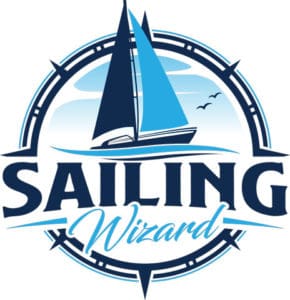
What’s the Difference Between a Boat, Yacht & Ship?
Whether you are a brand new sailor or just wanting to brush up on some terms, it is essential to know what to call a particular watercraft if you’re going to fit in while you’re at the docks or out on the water. There are many nuances and subtle differences between water vessel types, but below are some of the main differences.
In general, yachts are either sailing or motor vessels used for pleasure. Yachts are often luxurious and equipped with an overnight cabin. Boats can be either propelled sail or a motor and come in varying sizes. On the other hand, ships are usually motor-powered and much larger than boats.
Some of the differences between watercraft types can be a little fuzzy, but once you grasp the main differences between them, it becomes relatively easy to tell them apart. If you have no previous knowledge of watercraft, you are likely very confused about what defines a yacht, boat, and ship, so I’ll try to clarify any confusion you might have in the next few sections.
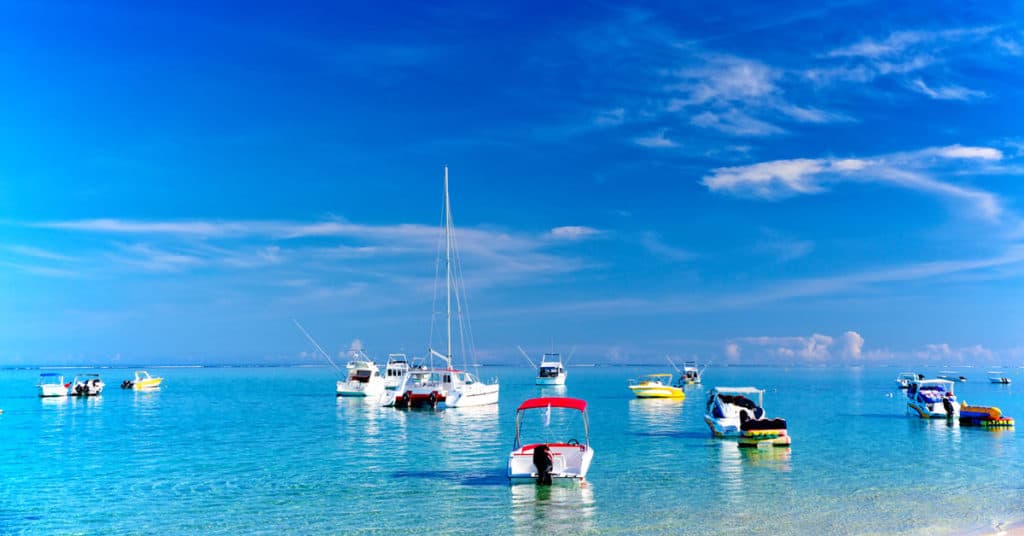
Similarities and Differences Between Boats, Yachts, and Ships
The many bodies of water all over the world are home to an extensive collection of different watercraft. There are so many shapes and sizes that they come in that it is nearly impossible to fit every single one into a specific classification.
However, in the following table, I did my best to loosely define ships, yachts, and boats so that it is easy to see the differences between the types of watercraft.
| Less than 197ft (60m) (usually ~25ft) | $15000 – $100,000+ | Pleasure, Residential, or Commercial | Motor, Wind, or Man Powered | |
| Greater than 33ft | $250,000 – $50,000,000+ | Pleasure | Motor or Wind Powered | |
| Greater than 197ft | $10,000,000 – $500,000,000+ | Pleasure, Residential, or Commercial | Motor Powered (Ancient Ships Used Wind or Man Power) |
As I mentioned earlier, it is impossible to fit EVERY SINGLE water vessel into a particular category, so there are tons of exceptions out there. In addition to the exceptions, different organizations, laws, and people classify types of boats slightly differently.
There is no universally accepted definition for ships, boats, and yachts, but instead many different sets of rules and regulations. In this article, I have tried my best to use the most commonly accepted definitions for each watercraft type.
Now that we’ve gone over some of the main differences and similarities between boats, ships, and yachts, let’s take a look at each type of vessel individually and look at their most prominent characteristics and attributes.
What Exactly is a Boat?
Boats come in a vast array of sizes and shapes. To many people, the term “boat” simply refers to nearly any watercraft, but there are actually a few restrictions and defining characteristics that all boats have. So let’s just get right into it and take a quick look at what exactly qualifies a vessel as a boat.
Overall Size of Boats
As I said before, there is a massive catalog of different types of boats, and they come in a variety of sizes. There are huge boats that hold lots of cargo or people, and then there are smaller ones that barely can stay afloat with a single person on board.
Typically, boats are defined as watercraft that are less than 197 feet long. However, most boats you are likely to encounter on the water are usually around 30 feet long.
General Price Range of Boats
Again, it is hard to accurately give a price range for all boats because they come in so many different sizes, styles, and types, but most modern boats seem to fall in the $1,500 to $100,000 range.
Small Jon boats can cost even less than $1,500, while large sailboats and houseboats can cost well above $100,000.
Most Common Uses of Boats
Boats are used all over the world for a variety of different reasons and to do many tasks. Many types of boats serve a wide range of uses, but most are primarily used as a residence, for pleasure, or commercially.
Some of the most popular types of boats, such as sailboats, bowriders, and dinghies, are commonly used for enjoyment, fishing, racing, or other pleasurable activities. There are also many types of houseboats used as residences and commercial boats used for chartering or moving goods or people.
Propulsion Method of Boats
Due to the wide variety of boats, you are likely to find boats propelled by almost every propulsion method imaginable. Some of the more popular propulsion methods for boats to use are man-power, wind power, and motor power.
Boats on the smaller end often use the power of the people on board to row or paddle, while larger boats rely on sails or powerful motors attached to the stern. Many boats use more than one propulsion method, either together or with one of them as a backup.
What Exactly is a Yacht?
Yachts have many of the same attributes as boats, but their quality, size, and luxury really set them apart. When someone says “yacht,” many people imagine watercraft that are SUPER LARGE, and while there are lots of massive yachts, many smaller boats also qualify as yachts, which might surprise you.
Overall Size of Yachts
There are many different sized yachts, and the rules regarding how big they have to be are not very strict. In general, luxury watercraft greater than 33 feet in length are considered yachts. However, boats smaller than 33 feet are sometimes called yachts if they are exceptionally luxurious and elegant.
There is no upper limit to how large a yacht can be. Yachts longer than 100 feet are often referred to as mega yachts, and ones over 150 feet long called are super yachts.
General Price Range of Yachts
Because the very definition of a yacht requires it to be very luxurious, they often come with quite a price tag as a result. There is quite a range of different price points for yachts, ranging from $250,000 to $50,000,000 and beyond.
Most Common Uses of Yachts
Yachts, because they are so expensive to maintain and purchase, are primarily used for pleasure purposes. Day trips out on the water are typical for yachts, although they often have overnight cabins, so longer excursions are popular.
Chartered yachts are also very popular, which bridges the gap between commercial and pleasure. Although, when you are on a chartered yacht, it is usually for the sole purpose of having a great time and enjoying yourself.
Propulsion Method of Yachts
Because yachts are considered very luxurious and often so large, they are usually solely propelling using motor power. Even if a yacht is on the smaller end of the spectrum, they often only use a motor as a means of driving the craft through the water.
However, many large sailing yachts out there use sails and the wind to propel the vessel. So while the large majority of yachts use motors, keep in mind that some large and luxurious sailboats can be considered yachts.
What Exactly is a Ship?
Throughout history, large ships have been a helpful tool for many civilizations and have allowed them to transport goods and explore places beyond their homes. In modern times, ships are quite common and are used for a variety of different reasons.
Overall Size of Ships
One of the primary characteristics of ships that set them apart from boats is their size. Ships, especially in modern times, are often MASSIVE and are restricted to navigating only extensive waterways.
Vessels greater than or equal to 197 feet long are often considered ships. However, most ships today are huge and often fall in the 1,000-foot range or larger.
General Price Range of Ships
Most individuals will never own a ship due to their extreme maintenance and the cost of purchasing one. While many smaller ships are far less expensive, most modern ships cost anywhere between $50 and $500 million.
Large and luxurious cruise ships can even cost upwards of $1 billion to construct, and that’s not even taking into account staff, maintenance, and other costs.
Most Common Uses of Ships
Ships perform many different duties throughout the world, but usually, they are used to transport passengers or goods over long distances. In addition, they are also often used by military, scientists, fishers, and a plethora of other professions and people. They are also often used for pleasure purposes, in the form of passenger cruise ships.
Overall, ships encompass a large selection of vessels that perform many different duties.
Propulsion Method of Ships
Due to their large size, most modern ships are propelled using motors. However, even though ships are equipped with massive motors, they are still pretty slow and often move at around 20 knots per hour, although some move much quicker.
While most, if not all, ships today use motors to propel themselves through the water, this was not always the case. Before motors were around, many civilizations used ships for military, exploration, transportation, shipping, and many other uses. During these times, ships were powered primarily by man and wind power. Even today, you can occasionally find a sail-powered ship, though they are quite rare.
James Gerard
Hi, I'm James! I started sailing at a very early age here in the UK, and have enjoyed so many opportunities to sail all over the world. I created this website to share the many sailing tips I've leaned over the years, so that you can also discover the joy of sailing with safety and confidence.
Recent Posts
How to Predict Wind Direction & Speed from a Surface Pressure Chart
Learning how to read a surface pressure chart will allow you to predict the wind speed and direction based on the weather chart. This will help you in planning your next sailing trip.
What Does a Black & Yellow Buoy Mean? (Cardinal Marks Explained)
If you see a black and yellow buoy while you're sailing, don't ignore it. Cardinal Marks are there to help you avoid hidden hazards in the water. This helpful article will help you to identify a...
BOOK NOW: 786 636-1008
AQUARIUS BOAT RENTAL & TOURS
- Giant Comfort
- Private Boat Tours
- Boat Rental with Captain
- Raccoon Island Tour
- Miami sightseeing boat tour
- Restaurants hopping
- Proposal in Miami
- Celebrity homes boat tour
- Sandbar cruises
- BYOB boat tours
- Boating lesson
- Bachelorette parties
- Miami Bachelor parties
- Celebrate a birthday on a boat
- Miami kids fishing
Frequently Asked Questions
- Best practices for boat renters
- Boat rental checklist
- Boating rules
- Boating safety
- Fun Boat pictures
- Miami boat pictures
- Giant Comfort boat pictures
- Aquarius Experience
- Groups over 10 people
- Request to split payment
- Corporate events
- Travel agencies and concierges
- Aquarius eco-responsibility commitments
- Reasons to pick Aquarius for Boat Rentals in Miami
- Check out our reviews
- Cancellation policy
- Weather policy
- Latest Boating News
- Rain insurance
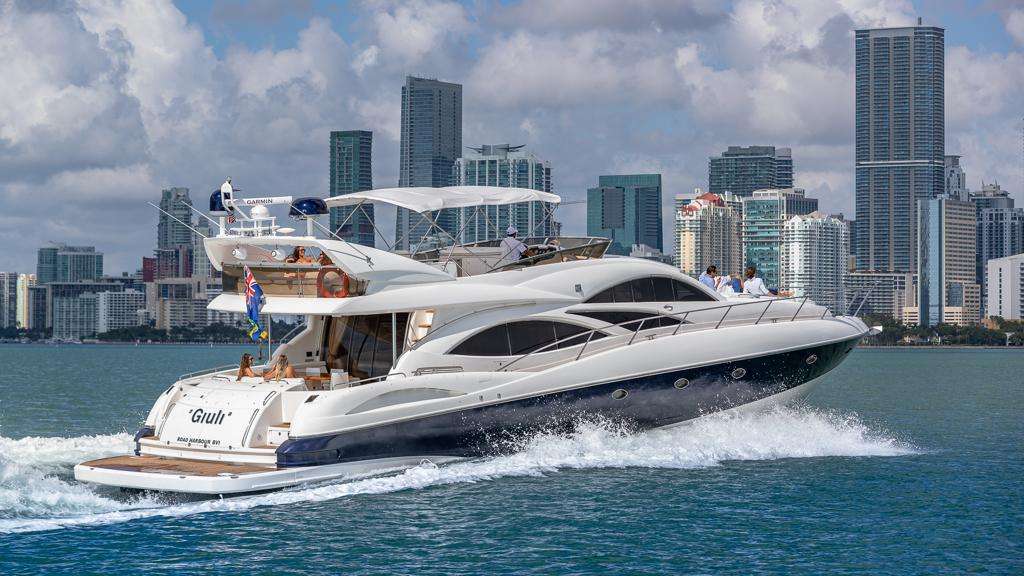
What Is The Difference Between A Boat And A Yacht?
Do you ever find yourself wondering about the difference between a boat and a yacht? Well, you're not alone! Many people use these terms interchangeably, but there are actually some key distinctions between the two. In this article, we'll dive into the world of boats and yachts, exploring their characteristics and shedding light on their unique qualities.
Picture this: you're out on the water, enjoying the sun and the gentle rocking of the waves. You might be aboard a boat, but is it a yacht? Here's where things get interesting. While both boats and yachts are vessels used for recreational purposes, the term "yacht" typically refers to a larger, more luxurious watercraft. It's the epitome of elegance and sophistication, often associated with opulent lifestyles and extravagant adventures.
So, what sets a yacht apart from a regular boat? Size is one crucial factor. While boats come in various shapes and sizes, yachts are generally larger, ranging from 40 feet to over 100 feet in length. They boast spacious cabins, multiple decks, and luxurious amenities, offering a true home away from home on the water. Yachts are designed with utmost comfort in mind, featuring plush furnishings, state-of-the-art technology, and even private spas or swimming pools.
But it's not just about size and luxury. Yachts are also known for their impressive capabilities and seaworthiness. These vessels are built to navigate open waters, allowing their owners to embark on extended journeys and explore far-flung destinations. With powerful engines and advanced navigation systems, yachts can take you on incredible adventures, whether you're cruising along the coast or crossing vast oceans.
Now that you have a better understanding of the distinction between boats and yachts, it's time to explore their fascinating world further. From the history of yachting to the different types of boats available, we'll delve into all aspects of these remarkable watercraft. So, grab your captain's hat and get ready to set sail on a journey of discovery as we unravel the mysteries of boats and yachts!
Boats and yachts are both water vessels, but they differ in size, purpose, and luxury. A boat is a general term that encompasses various types of watercraft, including small fishing boats, speedboats, and sailboats. On the other hand, a yacht is typically larger and more luxurious, often used for leisure or private purposes.
Yachts usually have more amenities, such as cabins, kitchens, and entertainment systems. While boats are more accessible and can be owned by individuals, yachts are often associated with wealth and are often chartered or owned by affluent individuals.
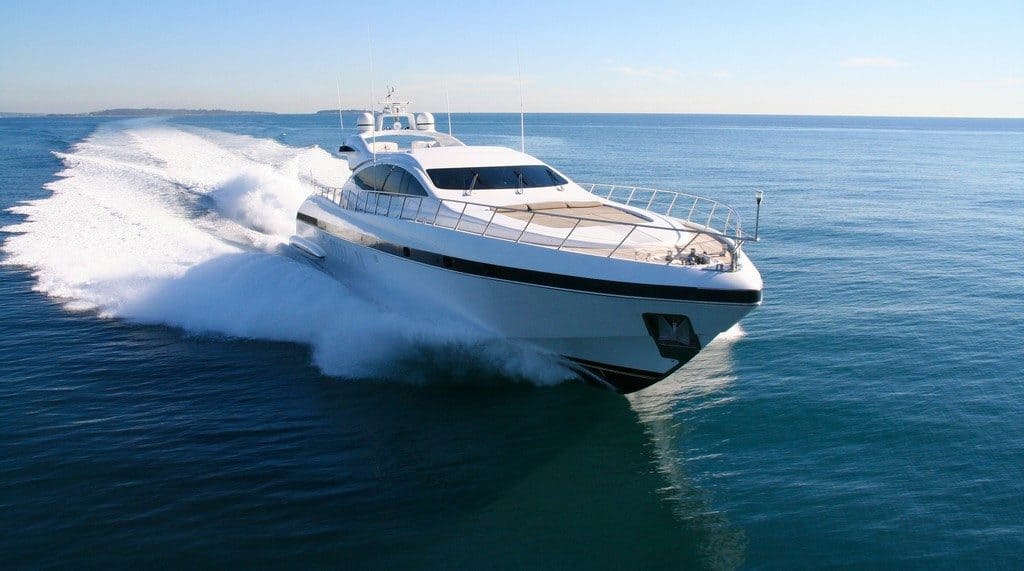
Welcome to Aquarius Boat Rental & Tours!
Aquarius Boat Rental & Tours is your premier destination for the best boat rental experiences in Miami, FL. As the #1 Boat Rental with Captain in South Florida, we take pride in offering the most reliable and enjoyable boat rentals to make your time on the water truly unforgettable.
Our Fleet: The Perfect Vessel for Your Needs
At Aquarius, we own all the boats we rent, ensuring the highest level of quality and safety for our customers. Whether you're looking for a fun boat for up to 6 people or a giant boat for up to 10 passengers, we have the perfect vessel to meet your needs.
Our boats are fully equipped with Bluetooth speakers, coolers, safety equipment, and floating mats, providing you with everything you need for a fantastic boating adventure. Whether you're planning a family outing, a special occasion, or just a day of fun on the water, our fleet has you covered.
Benefits of Renting a Boat from Aquarius
Renting a boat from Aquarius Boat Rental & Tours offers numerous benefits:
- Flexibility: With our customizable experiences, you have the freedom to create your own boating adventure. Our experienced captains can guide you to the best spots in Miami, or you can choose your own destinations. Whether you want to relax and sightsee or have a boat party with friends, we have you covered.
- Transparent Pricing : We believe in transparent pricing, and there are no hidden fees when you book with us. The captain fee is already included in the displayed price on our website. You'll know exactly what you're paying for, and there won't be any surprises when you arrive at the dock.
- Quality and Safety: As mentioned earlier, we own all our boats, ensuring the highest level of quality and safety. Our boats are well-maintained and regularly inspected to provide you with a worry-free boating experience .
- Exceptional Service: Our commitment to providing exceptional service is reflected in the glowing reviews from our satisfied customers. With over 300 five-star reviews, you can trust that your experience with us will be nothing short of extraordinary.
What Makes a Yacht Different from a Boat?
Now, let's dive into the main topic: the difference between a boat and a yacht. While the terms "boat" and "yacht" are often used interchangeably, there are some key distinctions between the two.
A boat is a general term that encompasses various types of water vessels. It can refer to anything from a small fishing boat to a sailboat or a motorboat. Boats are typically smaller in size and can be operated by an individual or a small crew.
On the other hand, a yacht is a specific type of boat associated with luxury and elegance. Yachts are larger in size and often equipped with luxurious amenities, such as spacious cabins, gourmet kitchens, and entertainment systems. Yachts are also crewed vessels, meaning they require a dedicated crew to operate and maintain them.
The Distinctions Between Boats and Yachts
Now that we have a general understanding of the difference between boats and yachts, let's explore some specific distinctions:
Size and Capacity
Size is one of the main factors that differentiate boats from yachts. Boats are generally smaller in size and have a lower passenger capacity. They are designed for recreational purposes and can accommodate a small number of people, typically up to 10 passengers.
Yachts, on the other hand, are much larger and can accommodate a larger number of people. They often have multiple decks, spacious cabins, and can accommodate anywhere from 10 to hundreds of passengers, depending on the size of the yacht.
Luxury and Amenities
While boats can be equipped with basic amenities and features, they usually lack the luxurious amenities associated with yachts. Yachts are known for their opulence and often feature high-end amenities such as jacuzzis, swimming pools, private cinemas, and even helipads. Yachts are designed to provide the ultimate luxury experience on the water.
Operational Requirements
Boats are generally easier to operate and require less specialized knowledge and training. They can be operated by individuals who possess the necessary boating licenses and certifications.
Yachts, on the other hand, require a more specialized crew to handle their operation and maintenance. Yachts often have a captain, crew members, and other staff members who ensure smooth sailing and provide top-notch service to the passengers.
Usage and Purpose
Boats are commonly used for recreational activities such as fishing, water sports, and day trips. They are versatile and can be used for various purposes based on their design and features.
Yachts, on the other hand, are primarily associated with luxury and leisure. They are often used for extravagant vacations, corporate events, parties, and other high-profile gatherings. Yachts provide a high level of comfort and exclusivity, making them the preferred choice for those seeking a lavish experience on the water.
Choosing the Right Vessel for Your Needs
When deciding between a boat and a yacht, it's important to consider your specific needs and preferences. If you're looking for a smaller, more intimate boating experience, a boat may be the ideal choice. On the other hand, if you're seeking a luxurious and extravagant experience with a larger group of people, a yacht may be the perfect option.
At Aquarius Boat Rental & Tours, we offer a wide range of boats and yachts to cater to different preferences and group sizes. Whether you're looking for a small boat for a family outing or a luxurious yacht for a special occasion, we have the perfect vessel for you.
Explore Miami's Beautiful Waters with Aquarius
As the leading boat rental service in Miami, Aquarius Boat Rental & Tours is committed to providing exceptional experiences on the water. Our fleet of boats and yachts, transparent pricing, and outstanding customer service set us apart from the competition.
When you choose Aquarius Boat Rental & Tours, you're not just renting a vessel; you're embarking on an unforgettable boating adventure. Explore Miami's beautiful waters, enjoy scenic views, and create lasting memories with your friends and family.
Easy Booking Process
Booking your boat rental with Aquarius is a breeze. Our user-friendly website allows you to easily reserve your boat online, saving you time and hassle. You can start planning your Miami boating experience with confidence, knowing that you've chosen the best boat rental service in town.
Contact Us Today
For any inquiries or to book your boat rental, feel free to call or text us at 786-636-1008 or email us at [email protected]. Our friendly team is always ready to assist you and provide guidance to ensure you have the best possible boating experience.
Discover the beauty of Miami's waters, indulge in luxury, and create unforgettable memories with Aquarius Boat Rental & Tours. Don't miss out on the opportunity to embark on the boating adventure of a lifetime. Book your Miami boat rental today!
Miami boat rentals , boat rentals Miami , boat rentals in Miami , rent a boat Miami , Miami boats for rent .
Key Takeaways: What is the Difference Between a Boat and a Yacht?
- A boat is a general term used to refer to any watercraft, while a yacht is a specific type of boat.
- Yachts are typically larger and more luxurious than regular boats.
- Boats are often used for recreational purposes, fishing, or transportation, while yachts are commonly associated with leisure and luxury.
- Yachts usually have more amenities and features, such as cabins, lounges, and even helicopters or submarines.
- The classification of a boat as a yacht is subjective and can vary depending on its size, value, and purpose.
Question 1: What are the main differences between a boat and a yacht?
A boat and a yacht are both types of watercraft, but there are some key differences between them. One of the main differences is the size. A boat is generally smaller and can be used for recreational purposes, fishing, or transportation. On the other hand, a yacht is typically larger and is often associated with luxury and leisure activities.
Another difference is the purpose. While boats can serve various purposes, such as fishing or water sports, yachts are primarily used for pleasure cruising and are equipped with amenities and facilities for entertainment and comfort. Yachts often have luxurious interiors, multiple cabins, and entertainment areas.
Question 2: Is there a difference in design between a boat and a yacht?
Yes, there can be differences in design between boats and yachts. Boats are generally designed for practicality and functionality, with a focus on maneuverability and efficiency. They may have a simpler layout and fewer amenities compared to yachts.
Yachts, on the other hand, are designed with luxury and comfort in mind. They often have spacious decks, multiple levels, and elegant interiors. Yachts may also have additional features such as swimming pools, jacuzzis, and helipads, depending on their size and purpose.
Question 3: Are there any legal distinctions between boats and yachts?
In terms of legal distinctions, the classification of a watercraft as a boat or a yacht can vary depending on the country and its regulations. Generally, the size and purpose of the vessel are taken into consideration. Some countries may define a yacht based on its length, while others may consider factors such as the presence of crew or commercial use.
It's important to note that the legal distinction may have implications for licensing requirements, safety regulations, and tax considerations. It's recommended to consult local maritime authorities or legal experts for specific information regarding the classification of a watercraft.
Question 4: Can a boat be considered a yacht?
While a boat and a yacht have distinct characteristics, there can be some overlap between the two. In some cases, a boat can be considered a yacht if it meets certain criteria, such as size, amenities, and purpose. For example, a larger, luxurious boat with high-end features and designed for recreational cruising may be classified as a yacht.
Ultimately, the classification of a watercraft as a boat or a yacht can be subjective and may vary depending on individual perceptions and industry standards.
Question 5: Do boats and yachts have different costs associated with them?
Yes, boats and yachts can have different costs associated with them. Generally, boats tend to be more affordable compared to yachts. The price of a boat can vary depending on its size, brand, features, and condition.
Yachts, on the other hand, are typically more expensive due to their larger size, luxurious amenities, and higher maintenance costs. Yachts can range from a few hundred thousand dollars to millions of dollars, depending on their size, brand, design, and customization options.
What Differentiates Ships From Boats?
Final Summary
So, what's the difference between a boat and a yacht? Well, it turns out that size does matter! While both boats and yachts are vessels used for recreational purposes on the water, there are some distinct characteristics that set them apart.
Firstly, let's talk about size. A boat is generally smaller in size and can range from a small dinghy to a luxurious motorboat. On the other hand, a yacht is typically larger and more luxurious, often equipped with amenities such as cabins, kitchens, and even swimming pools. It's the epitome of luxury on the water.
Another factor that sets them apart is their purpose. While boats are mainly used for recreational activities like fishing, water skiing, or cruising, yachts are often associated with leisure and entertainment. They are commonly used for hosting parties, corporate events, or even as a floating vacation home.
In terms of prestige, yachts take the crown. Owning a yacht is often seen as a symbol of wealth and status, while owning a boat is more accessible to the average person. Yachts are often associated with the rich and famous, and you might even catch a glimpse of celebrities lounging on their extravagant vessels.
In conclusion, the difference between a boat and a yacht boils down to size, luxury, and purpose. While boats are smaller and cater to a variety of recreational activities, yachts are larger, more luxurious, and often associated with wealth and prestige. So whether you're sailing on a boat or cruising on a yacht, there's no denying the allure of the open water.


Boating Basics Online is reader-supported. When you buy via our links, we may earn a commission at no cost to you. Learn more
Difference Between a Boat and a Yacht That You Want to Know
Written by J. Harvey / Fact checked by S. Numbers
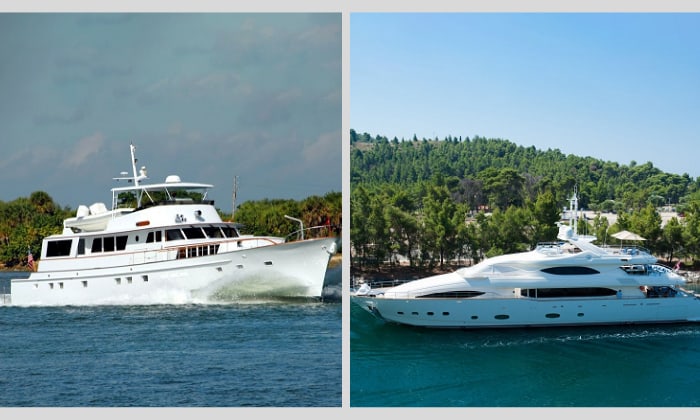
When people see a gleaming white boat on the water that exudes a certain prestige, such a luxurious-looking boat is immediately thought of as a yacht. But what exactly is the difference between a boat and a yacht and how do you differentiate between them?
We’ll take a closer look at yachts and make a comparison between them and boats. Let’s also examine the characteristics of boats, so we can have an easier time identifying them.
Let’s get started.
Table of Contents
2. Facility
What is a boat, 2. propulsion, 3. operation time, what is a yacht, 4. performance, comparison: yacht vs boat.
- Yachts have no set limit, while a large boat exceeding a certain size is called a ship
- The superyacht, mega yacht, and Giga yacht are larger yacht types
- A yacht is usually a recreational boat that focuses on comfort amenities
- Boats usually do not focus as heavily on comfort amenities
- Boats have a wide variety of purposes
- Yachts are mainly for recreational purposes and entertaining guests
The boat is a watercraft that traverses the surface of the water. There are many types of boats, and they have a very wide range of sizes, lengths, and designs. Boats also cover a very wide range of uses and purposes.
Fishing boats, police boats, trading boats—there are many uses for boats. There are also many other boats that are specialized for other activities such as racing.
Characteristics of Boats
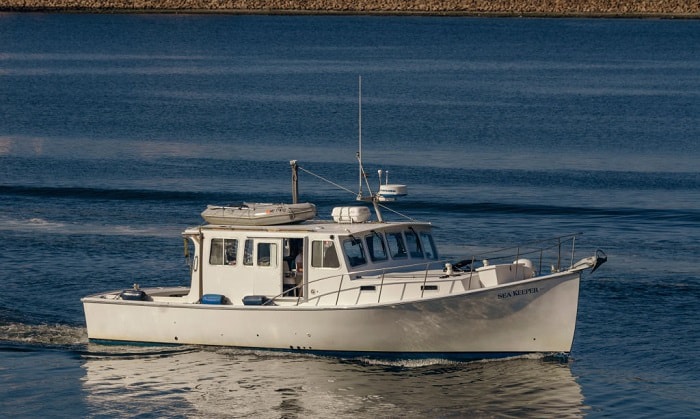
Boats can be under 16 ft and reach up to 64 feet. However, there are much bigger boats that are well over the usual limits for boat length and weight; these boats include tugboats and certain freighters.
Whether a big boat is called a ship depends on its purpose.
Larger boats are called ships, but it’s usually their weight and purpose that defines this classification. In some countries, purpose alone distinguishes ships from boats. Usually, a boat for transporting goods and passengers through oceans is considered a ship.
There are many types of propulsion used for the different types of boats. They fall into one of three categories: human-powered, wind-powered, or engine-powered. Human-powered boats are those that need people to row using oars or paddles.
The sailboat is a wind-powered boat that relies on sails to move and is highly dependent on the wind. Sailboats in the past that relied on trade winds to ferry goods between countries are good examples.
Engine-powered boats refer to boats with motors, regardless of the type of motor used. A wide variety of engines have been used for boats such as the steam engine and the modern engine. Small engines can power smaller vessels with ease.
Another distinguishing point of boats is their operation time or how long they can sail out in the open sea. To be more accurate, it’s their operation limit.
With their smaller size and limited living space, boats cannot sail for long periods and have to dock regularly. On the other hand, a ship can sail for extended periods.
Standard boats do not require a lot of people to operate and are typically operated by as few as one person. However, it’s not just that boats don’t need a full crew to operate, they just don’t have enough space.
The definition of a yacht is tricky and what size boat is considered a yacht is difficult to answer definitively. Taking a look at boat vs yacht does make it easier to understand what yachts are.
While yachts are boats, many are able to distinguish boats and yachts due to the latter’s extravagant appearance, but there is more to yachts than being just a pretty floating object. A yacht needs to have style and substance: it needs to have a purpose; it needs to have a high level of performance; and it needs to look good.
The word yacht comes from the Dutch word “jacht” meaning hunt. As far as naming is concerned, whether a vessel’s a yacht is really up to the manufacturer.
Is a yacht a ship? No, a ship is used for commercial purposes, not recreational activities, unlike yachts.
Generally, yachts need to have a few characteristics.
Characteristics of a Yacht
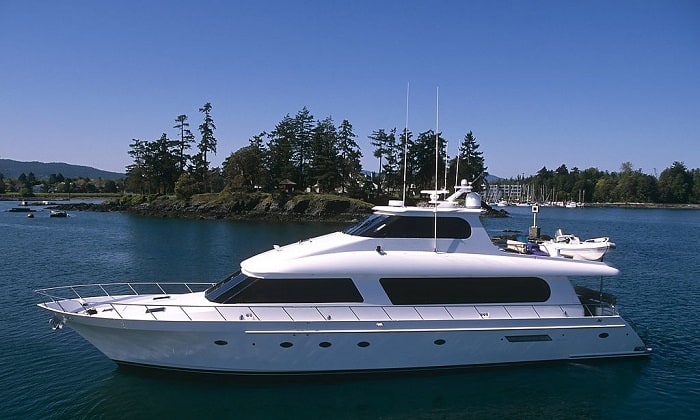
While there are no standard yacht sizes in feet, there needs to be enough space on a yacht for comfort amenities. Living space is considered a necessity due to the fact that the concept of yachts came about when a hunting boat was used by the Dutch navy to entertain important guests. In general, a yacht is 33 ft or longer in length.
A few other factors that also come into play are crew space, recreational amenities, and cargo space. Currently, the biggest recreational yacht is the Azzam, which is 590ft long. Yachts are also expected to have a high level of performance, which means they must have enough space for powerful engines and operation systems.
Big yachts often fall in three categories: Super yachts, mega yachts, and giga yachts. Super yachts are over 100 feet long. Mega Yachts are usually longer than 2oo feet, while Giga yachts are much bigger and reach lengths of over 300 feet.
Historically, yachts have been known to be sailing yachts. There was a time when people were doubtful of motorized boats being considered yachts. This is due to the first yachts being wind-powered and the design staying close to the original for around three centuries.
Motor yachts are more common these days, though yacht engines are never outboard motors. It makes sense, since it’s easy to imagine an outboard motor ruining the prestige of a yacht by over-protruding on one side.
Yachts are known for luxury. There is nothing more extravagant than making yourself feel at home in the middle of nature, and that’s exactly what a yacht affords. With its living quarters, seating area, dining space, and various other amenities, a yacht is like having your own hotel on the water.
Aside from having that level of comfort, being able to accommodate a number of guests on the yacht as well makes this a show of wealth like no other. High-tech yacht electronics make yachts easily capable of providing comfort at the level of a private cruise service.
Aside from the luxury that yachts afford, they’re also known for their high level of performance. Bigger yachts can run at speeds of around 35 knots or 40 miles per hour. Smaller yachts can also run fast, depending on the vessel’s weight and the amount of living space.
The world’s fastest yacht is a 41.5-meter long motor yacht that can go as fast as 70 knots. Many custom-built yachts reach speeds of over 40 knots in calm waters.
Now that you’ve seen the key characteristics of yachts, you won’t need to wonder about the difference between a boat and a yacht. While a yacht definition is still hard to make, you’ll no longer have a hard time identifying them.
If you know anyone else wondering what makes a boat a yacht, please share this article with them as well. Also, if you have any thoughts or comments about yachts, feel free to leave them below.
Remember to boat safely.

“My intention from the first day establishing Boating Basics Online is to provide as much help as possible for boaters who want to experience a first safe and convenient trip. So feel free to join us and share your beautiful journeys to the sea!”
What’s the Difference Between a Boat and a Yacht?
If you’re in the market for a new boat, you may be weighing your options between a powerboat, a yacht, or something else. But what’s the difference? To help you choose a craft that best suits your lifestyle and needs, this article is going to weigh the main differences between a boat and a yacht.

Boats and Yachts
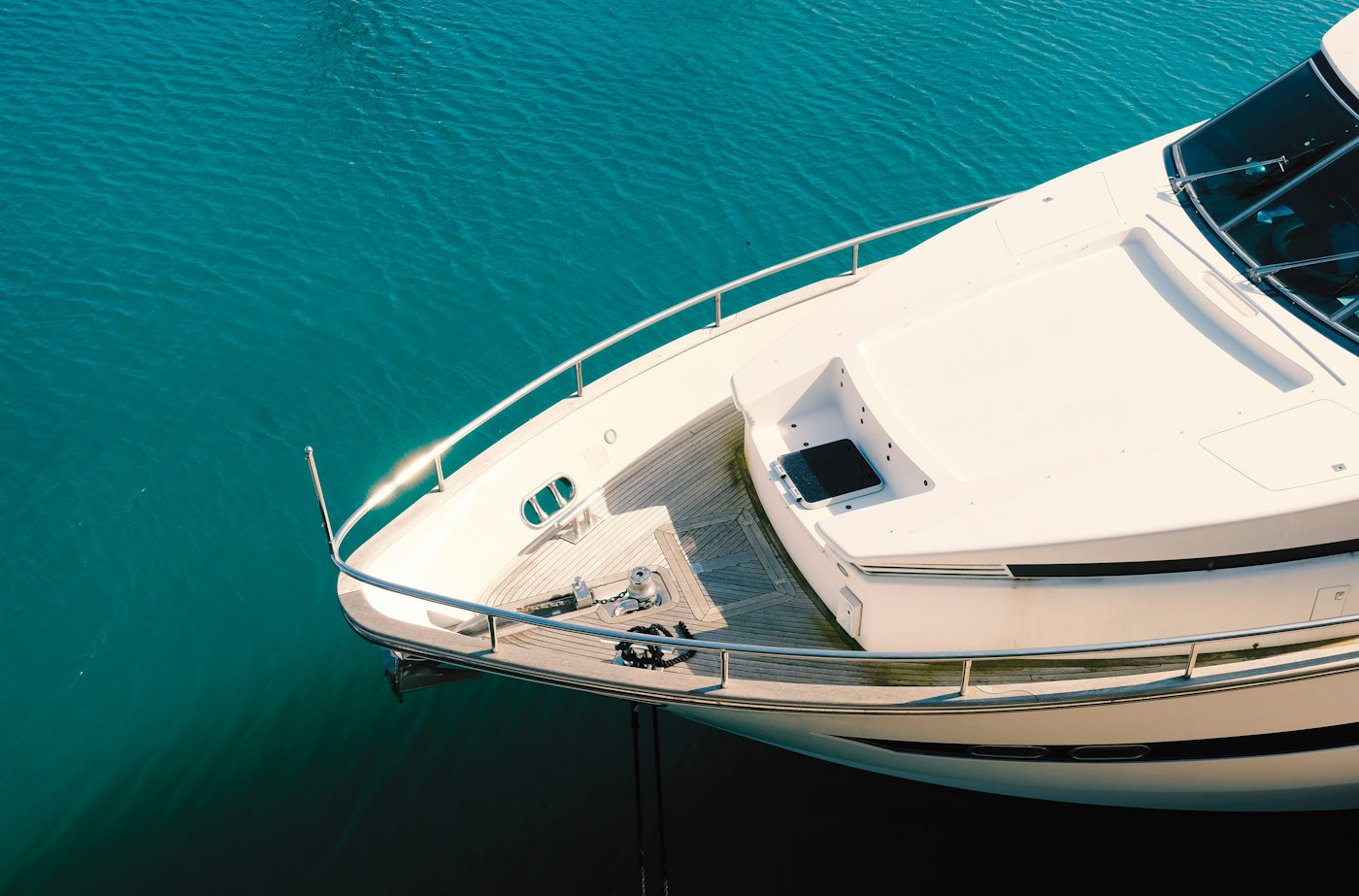
With so many different types of yachts to choose from, it can be hard to know your Flybridges from your Tri-Decks if you’re just starting your search. Although there is a growing number of terms used to describe the different types of yachts out there, many of the terms overlap or are used interchangeably.
If you’re on the market for a yacht, the team here at Van Isle Marina has compiled a review of the different terms you’ll likely come across when cruising through yachts for sale .
The term ‘boat’ is used to describe any water vessel, propelled by either sails, an engine, or manpower. It’s not very specific, which means yachts, dingeys, and everything in between technically falls under the blanket term ‘boat’.
The term ‘yacht’ brings a little more prestige and sophistication with its origin story, being derived from the word “hunter” in Dutch. Hundreds of years ago, the Dutch navy built and sailed yachts to literally hunt down pirate ships in shallow waters. That’s part of the reason why both powerboats and sailboats can be classified as ‘yachts. It didn’t take long for other nations to catch on, using the Dutch idea for navy ships and eventually racing vessels and private, recreational vessels.
The size is one of the most common factors used to determine whether a boat should be classified as a yacht or not. When it comes to size, there are no official rules, so it depends on who you ask. Some will say the boat needs to be at least 35 feet to qualify as a yacht – others will say even longer. If you’re yacht is more than 75 feet, you’re approaching Super Yacht range, and if it’s more than 250 feet you’re in Mega Yacht territory.
Despite the uncertainty around size-based classification, typically, you’ll know it when you see it. That massive vessel that looks like it could sleep a 10+ and needs a dozen ropes to secure it to the dock? That’s definitely a yacht. And that small, single-level boat with not a lot of room to stand? That’s definitely a boat.
The downside of using size as the only determining factor is it’s black and white. If you set the boundaries with size, there’s no room for gray area. Let’s explore more…
Luxury Living

Yachts are an international symbol of luxury and wealth around the world. The yacht is synonymous with luxury, which can actually help us when classifying boats as yachts or not. If the boat is built with luxury top of mind, it is probably a yacht.
How do you spot luxury? From the shore, the exterior of a yacht is typically sleeker with distinct accent styles. But the real luxury becomes evident when you step on board. Yachts are built with spacious living areas, full size kitchen and bathrooms, advanced TV and audio systems, and designer-style furnishings. You might even find hot tubs, a pool, and a helicopter pad in ultra-luxurious cases.
If you’re closing in on the purchase of your new boat and you’re still unsure whether it’s a yacht or not, the price tag should give you some indication. Yachts are known to cost far more than boats, due to their level of luxury and comfort, size, and usage. For a brand-new yacht, you can easily pay $100,000+ per foot, which means you’re looking at millions of dollars for the total price.
There are other costs to consider as well. Because yachts are larger, most will require a professional crew (or at least a captain) on board. Then there’s maintenance and insurance, both of which will cost more for a yacht.

Another key differentiator between boats and yachts is what their purpose – what they’re being used for out on the water. There is no nailed down definition of what makes a yacht a yacht, but most boaters consider a yacht to be any type of sea vessel that is used strictly for recreational or pleasure purposes like cruising , entertaining, water sports, fishing , or year-round accommodations.
The only purpose of a yacht is recreation. But more specifically, yachts are designed for personal pleasure and leisure, whether that’s long, ocean-crossing journeys or anchoring near a buzzing port town.
On the other hand, if the vessel is doing a job or being used for a specific activity, it’s not a yacht. If the boat is involved in any commercial activity, it’s only a boat. Even if it’s being used recreationally, for example fishing or watersports, the boat is still a boat.
Handling Conditions

When you’re out on the open ocean, you’ll have high winds and dangerous waters to deal with. In these conditions, size will definitely work to your advantage. And while you’re closer to shore, you can expect the conditions to be much calmer.
When it comes to dealing with conditions, one worthwhile classification system places boats into one of 4 categories, labelled A through D:
Class A : These are large yachts capable of handling high winds (force 8 on the Beaufort scale) and up to 13-foot waves in the open ocean. These boats are certainly yachts and are built for the open ocean.
Class B : While these yachts aren’t quite designed for the open ocean, they’re very capable craft. Also known as “ offshore vessels ”, Class B yachts are best suited for waters less than 200 miles (321km) from shore.
Class C : Class C boats are typically known as ‘boats’, as they’re designed for inshore and nearshore excursions – not the open ocean. These boats are fine with waves a few feet high, but anything higher than that is dangerous.
Class D : These boats are typically small ones and are not built for harsh conditions. These craft can handle winds of up to 25km/hour and waves just a couple feet high.
Types of Yachts
A yacht is first defined either as a sailing yacht, motor yacht, or gulet yacht, and then as a sports yacht or luxury yacht.
- Sailing Yacht: a yacht mainly propelled via wind and sails
- Motor Yacht: a yacht propelled via one or more motors
- Gulet Yacht: a hybrid yacht with both sails and motors
- Open Yacht, Cruiser, Cabin Cruiser, Express Cruiser: an otherwise uncategorized standard yacht for cruising and entertaining
- Luxury Yacht: a yacht that includes high-end finishes and features and the latest in modern performance technology. The term ‘luxury’ can precede any type of yacht, i.e. “luxury motor yacht”, “luxury sailing yacht”, etc.
- Sports Yacht : a yacht geared towards fishing, water sports, or cruising with a sleeker design and more powerful motor for faster cruising speeds. The term ‘sports’ can precede other types of yachts as well, i.e. “sports motor yacht”.
- Catamaran Yacht: a yacht with two hulls (pontoons) often made of fiberglass that can be used in shallow waters.
Yacht Style Categories

Yachts can further be grouped or defined according to their form and function, such as with flybridge, sedan, pilot house, and sportfish yachts, for example.
- Classic Motor Yacht: a yacht that was built between the 1920s and 1970s (before today’s modern technology began dominating modern yacht manufacturing). A modern yacht can be built based on the classic motor yacht style.
- Sedan: a popular yacht style with deck space above the hull and living quarters below. The living quarters of a sedan yacht are enclosed and single-level.
- Flybridge: a sedan-style yacht with an open deck and more comfortable living space above the main bridge of a vessel.
- Daybridge: a multi-level yacht that is even more open than a flybridge. Belize Motoryachts are known for creating this distinctive style of yacht.
- Open or Enclosed: a term used to describe the layout of and access to the flybridge. In an enclosed flybridge, access to the above flybridge is enclosed inside the living space. In an open flybridge, access to the flybridge above is open to the elements.
- Downeast Style: a low-profile yacht with a large working cockpit and small helm station. This highly recognizable style is inspired by the mid-1900s traditional Maine lobster boat. Back Cove yachts are a shining example of downeast-style inspired yachts.
- Pilothouse: A multi-deck yacht like a flybridge with a larger interior main deck.
- Sky Lounge: an enclosed area at the top of the vessel that provides the benefits of the view but with several amenities, protection from the elements, expansive windows and sometimes a sunroof.
- Cockpit Motor Yacht: a yacht with more cockpit space than deck space.
- Sportfish or Sport Fishing Yacht: A yacht used for fishing with a large cockpit, storage space, and the ability to handle rougher seas. These can also be referred to as Flybridge Sportfish or Sportfish Express and are built for longer durations out on the water.
- Convertible: a yacht that combines features of a standard motor yacht with a sportfish yacht to have entertaining space when you need it, and also fishing space when you need it.
- SUV: a yacht that combines features of a standard motor yacht and sport yacht.
- Tri-Decks : a superyacht with three levels of staggered, enclosed living space.
- Expedition Yachts: a large yacht with a deeper displacement hull for more stability and comfort during longer-range trips.
There are dozens of governing bodies, societies, and other organizations that set standards, classifications, and definitions in the world of boating. There are different authorities like this all over the world, so it’s a good idea to check-in with local groups or areas you plan to visit.
If you’re in the market for a new boat or yacht, head over to Van Isle Marina on Harbour Road in Sidney, BC. You can browse our selection of yachts for sale on our website, but be sure to stop by the marina to check out our facilities, fuel dock and Sea Glass Waterfront Grill .
250 656 1138
2320 Harbour Road, Sidney, British Columbia V8L 2P6 [email protected]
Marina Services
Marina Layout
Yacht Sales
- Link to Facebook
- Link to Instagram
©2024 Van Isle Marina | Design by Caorda
- Yachts for Sale
- Sales Report 2024
- FAQ – Luxury Crewed Yacht Charters
- FAQ – Bareboat charters
- FAQ – Sell your Boat
- FAQ – Buying a Yacht
- How Much does it Cost to Charter a Luxury Yacht?
- All Blog Posts and News
- Yachting for beginners
- Indian Ocean
- Mediterranean
- Sales & New build
- Motor Yacht
- Event & News

Yacht Vs Boat: What is the Difference?

Definitions of words such as “yacht”, “boat”, or even “ship” are not always clear. Most of us make our own (unspoken) rules up, while others simply go with the flow and call their vessel whatever comes up at the moment.
So when does a boat become a yacht? Are all boats yachts? Are all yachts boats? What about ships?
Here is our subjective take on this vital matter.
The definition of a boat
In spoken or written English, it seems that anything able to float can be called a boat . It has little to do with size, function, or fit-and-finish. It is the most general term.
According to many dictionaries, boats are defined as “small vessels for traveling over water, propelled by oars, sails, or an engine”. So, a boat can have recreational purposes as well as commercial ones, but it is expected to be quite limited in size.
A yacht : our unofficial definition
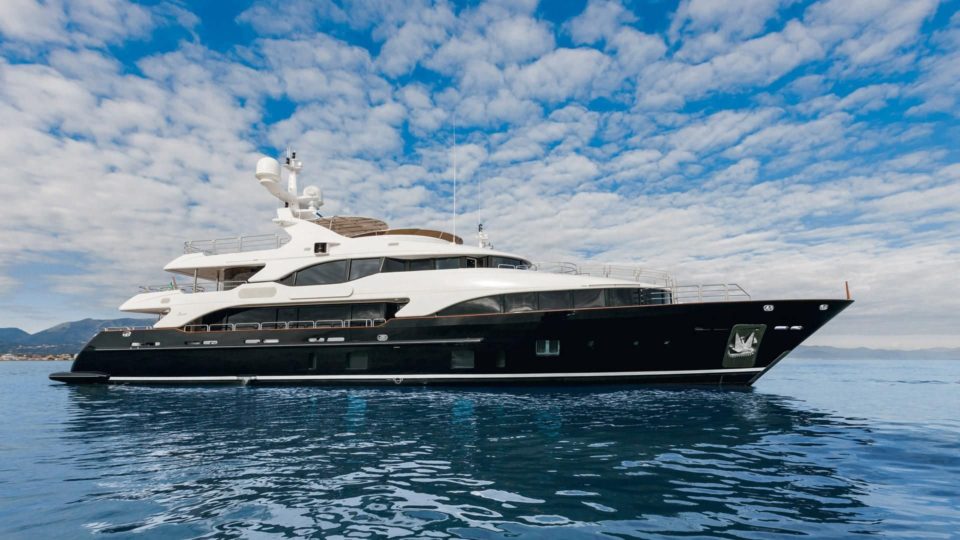
The word “yacht” generally refers to a more sophisticated craft than a boat or a ship.
Yachts can be sailed or motorized: so catamaran, monohulls, or even trimarans can also be called “yachts”.
To deserve their name, they have to be comfortable, spacious, well equipped and built with luxury in mind.
Regarding their functions, yachts are purely recreational.
They are designed for relaxation and leisure first, even though they can be suitable for long stays at sea and transatlantic crossings.
To sum up, as soon as your boat is a certain size and boasts several luxury features designed for leisure, then you can call it a yacht.
The definition of a ship
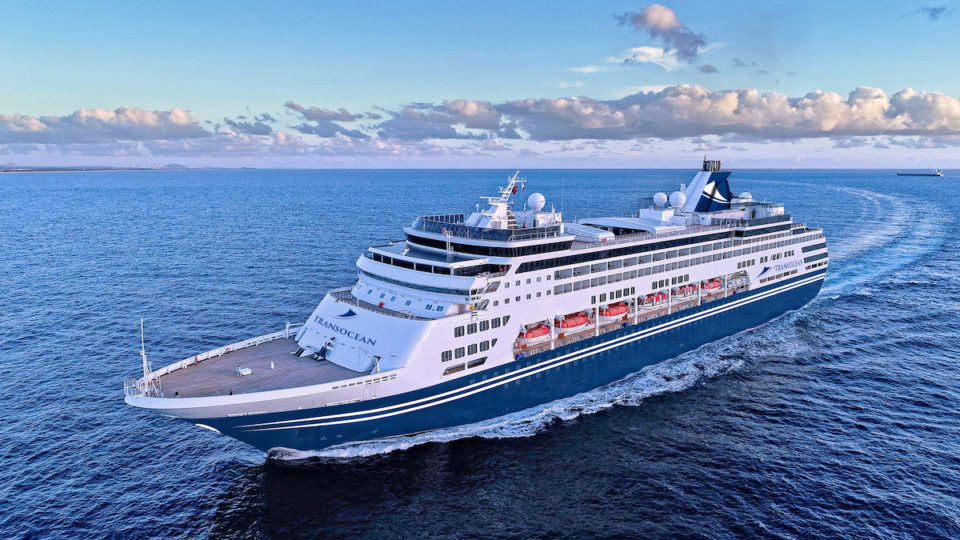
According to the Oxford dictionary, a ship is “a large boat for transporting people or goods by sea”.
The ship is associated with something larger and less fancy than a boat.
It is a “working” vessel, unlike yachts which are made for leisure purposes.
A ship usually needs a full crew to operate. A yacht might need a full crew to operate depending on its size. A boat usually implies smaller vessels and therefore most of them don’t need a crew.
Common vessels that are called “ships” include ferries, petrol tankers, or warships.
Details to look at to know if you are dealing with a boat, a yacht, or a ship
The size: one of the strong factors to identify a boat vs a yacht.
Size is one of the most determining factors to know how to call your vessel.
A boat is often expected to be smaller than a ship or a yacht. Generally, a vessel anywhere from 15-30 feet in length will be called a boat.
Starting from 15 meters (50 feet), private luxury recreational crafts can be considered yachts.
Starting from 24 meters (79 feet), you are entering the superyachts area.
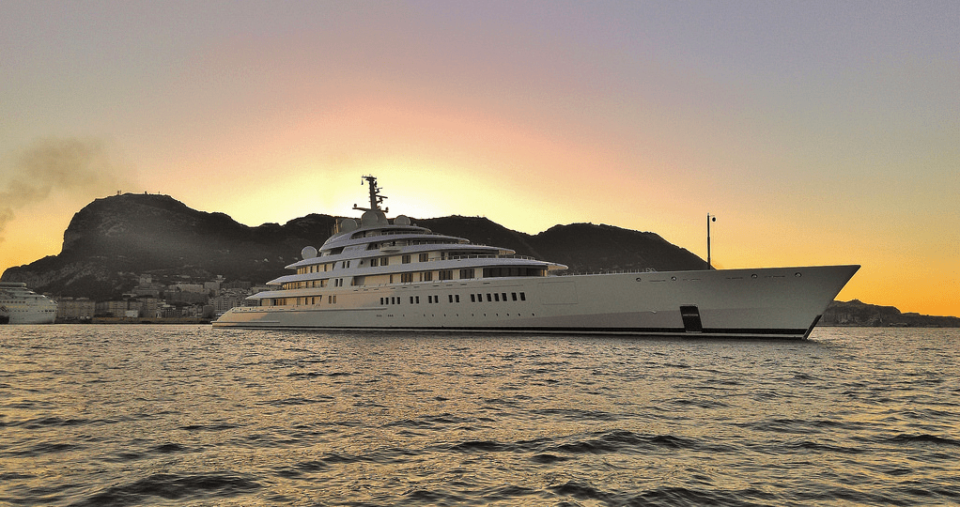
Above, 50 meters can start talking about mega yachts. Obviously, there is no upper limit to mega yachts. Currently, Azzam, the world’s biggest yacht is 180 meters long (590 feet).
So when it comes to differentiating between boat and yacht, size does matter.
But size alone isn’t enough to know the sort of vessel you are dealing with.
The function of a yacht vs a boat isn’t the same
The main function of its vessel is one of the easiest ways to recognize a boat from a ship or a yacht.
Boats can be used for both leisure and business (fishing, day trips, police, …) depending on their size and options.
On the other hand, a yacht has a purely recreational function. Unlike a “boat”, it can be used for long voyages on oceans thanks to its larger size, better propulsion, advanced electronics, guidance, and safety equipment, but especially thanks to its comfort. Yachts can protect passengers from bad weather and the comfortable cabins can accommodate several passengers for long stays. Yachts are also often available for charter with a staff taking care of the guests at a high standard of comfort.
Ships primarily have commercial functions. It can be forwarding freight, crossing the sea with thousands of people on board, or going on a warzone with a unit and its material.
To add to the confusion, some mega yachts such as Christina O could be called ships due to their initial function or their size.
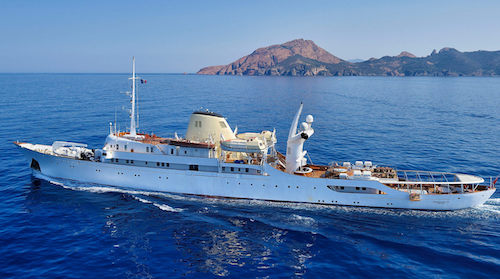
Besides these exceptions, it’s quite obvious to recognize a yacht from a boat or a ship simply by its size and the luxury of its amenities.
The luxury on board makes it a yacht or a boat
A yacht is a recreational vessel designed with luxury and comfort in mind.
The facilities, be it furniture, rooms, living spaces, safety equipment, and navigation systems are all luxurious on a yacht.
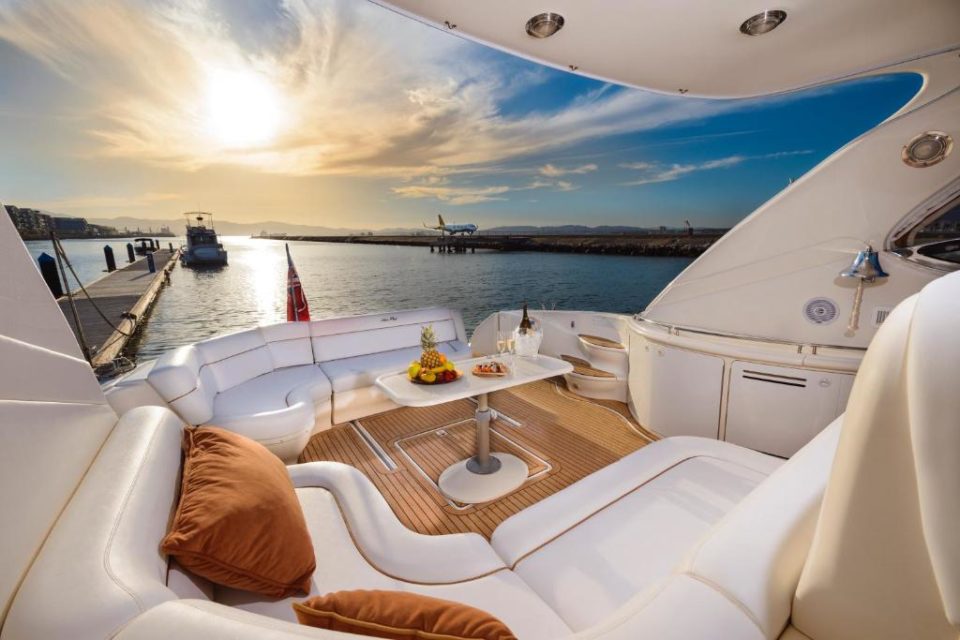
The notion of space is often very important to feel comfortable on board, even for long cruises. The largest and most luxurious yachts have various spaces such as beaches, sundecks … to make life on board as comfortable as on land, if not more.
To make it simple, if a vessel is luxurious, then more often than not, it’s a yacht.
Check out all our luxury yachts here.
The propulsion of the vessel can determine whether it’s a yacht or a boat
A boat can be rowed, propelled with its sails, or with one or several engines.
Motorized small boats can have impressive speed on the water thanks to their lightweight, but their engines are usually less powerful and sophisticated than yacht engines.
Some boats can sail long-distance when they are well equipped, such as solar panel, water maker etc.
On the other hand, equipment on yachts make them able to operate over very long distances, including crossing oceans.
Most ships are designed to cross the sea with safety and they are designed for this objective.
Looking at the propulsion is therefore not enough to know if a vessel is a boat, a yacht, or a ship, although it can give you a few clues.
The crew on board can tell the difference between a boat and a yacht
Commercial ships and professional boats obviously have experienced captains to sail them around the rough corners of the globe.
For yachts and leisure boats, it is less obvious.

Big yachts owners usually employ professionals to sail, but also manage the daily operations onboard. The number of enrolled crew members depends on the yacht’ size.
Usually, boats do not need a professional enrolled skipper to operate, if you know how to sail. But you can always rent a boat and hire a skipper to bring you wherever you want.
So, what should you call your vessel?
To make it simple, if your vessel is a luxury craft above 50 feet, designed for fun, recreation, relaxation, and comfort, then call it a yacht.
Anything below that size, call it a boat.
If you own a working craft rather than something recreational, especially if it’s a long vessel, then you are free to call it a ship.
But let’s be honest, nobody will blame you if you use the wrong term. You are entirely free to continue calling your canoe a yacht if you like it that way!
Read Also : How Much does it Cost to Charter a Luxury Yacht?
Starting from 50 feet (15 meters), a pleasure boat is usually considered a yacht.
Yes, a 40-feet boat can be considered a yacht if it has recreational use and a luxurious outfit. Otherwise, it is only a boat!
By definition, a ship is a large vessel that crosses oceans and other deep waters for commercial purposes. It carries cargo or passengers or performs specialized missions, such as defense, research, and fishing. So a boat becomes a ship when it is big, it weighs at least 500 tonnes or above and it has commercial use.
Private recreational boats from 33 feet are actually yachts. Luxury is also an important point once defining a yacht.
No. If the boat doesn’t have a recreational purpose, if it is below 33 feet long (10 meters), or if it is not luxurious, it is not a yacht but a boat!
RELATED ARTICLES MORE FROM AUTHOR
Luxury crewed yacht charters – frequently asked questions, luxury yachts for charter perfectly suited for 10 guests, skipper’s job and responsibilities: what you should know.
- Testimonials
- Privacy Policy

The Key Differences Between a Yacht and a Boat | Yacht vs Boat
Olivia benjamin.
- June 20, 2023

It’s a common misconception to assume that there is no difference between a yacht and a boat, but there are notable differences between these two types of watercraft. Yachts are generally larger and more luxurious than boats, typically smaller and designed for recreational activities such as fishing or water sports.
While yachts and boats serve as leisure vessels on the water, yachts often boast additional amenities like air conditioning, multiple bedrooms, and even hot tubs. Conversely, boats tend to have simpler features, such as a small cabin or storage space for fishing equipment.
Gaining a deeper understanding of these differences can assist you in determining whether to choose a yacht or a boat based on your unique needs and preferences. So, let’s dive deeper into the distinctions between these two types of vessels.
What is a Yacht and What is a Boat?
Boats and yachts are two terms that are often used interchangeably, but there are distinct differences between them. Let’s examine the differences between boats and yachts.
What is a Yacht?
You might think of a yacht as a luxurious vessel often used for leisure activities, like sailing the high seas or throwing lavish parties on board.
Yachts are typically larger than boats and have amenities such as multiple cabins, bathrooms, kitchens, and entertainment areas. They’re designed for comfort and style rather than speed or efficiency.
However, it’s important to note that not all yachts are the same. Some may be motorized, while others require sails to move through the water.
Moreover, there are several types of yachts, including racing yachts, cruising yachts, and mega yachts, with sizes ranging from 33 to over 160 feet. Each type caters to specific preferences and requirements, ensuring a tailored yachting experience.

What is a Boat?
A boat is a watercraft primarily designed to float, move, and navigate on water. It is a generic term that refers to a wide range of vessels used for various purposes such as recreation, transportation, military, commercial use, or fishing.
Boats come in different sizes, designs, and types, each serving a specific need. Small boats like kayaks and canoes are used for recreational purposes, while larger boats like tugboats serve commercial purposes.
Whether used for pleasure or work, boats offer great maneuverability. They can navigate in shallow waters and tight spaces and come equipped with navigation and other systems.

Boat vs Yacht | What is the difference between a Yacht and a Boat?
Do you want to know the differences between yachts and boats? Well, there are several key points to consider.
A boat is a generic term used to refer to any small watercraft. At the same time, a yacht is a specific type of boat often associated with luxury and recreational purposes. Many differences exist between yachts and boats, including the use, size, construction of these vessels, and many more.
Let’s explore these differences in detail to help you understand the unique qualities of each type of watercraft.
Difference in Size
Yachts are typically larger than boats, often measuring over 40 feet long. While boats come in various sizes, they often range from around 20-30 feet in length.
Boats are usually smaller and built for leisurely activities like fishing or cruising on lakes and rivers. On the other hand, yachts are designed for luxurious living at sea and are often equipped with multiple cabins, bathrooms, entertainment areas, and even swimming pools.
The size difference between yachts and boats also affects their handling of the water. Due to their large size and complex systems, yachts require experienced crews to operate them. Boats, on the other hand, can be easily handled by anyone with basic boating knowledge.
Difference in Use
While both vessels are designed for water travel but serve very different purposes, boats are typically smaller vessels used for recreational activities such as fishing, water sports, and short trips along the coast. They’re also commonly used for transportation in areas with many waterways.
Yachts, on the other hand, are much larger and more luxurious than most boats. They’re typically owned by wealthy individuals or companies and used for leisurely cruising or entertaining guests. Some yachts can even be chartered for special events such as weddings or corporate retreats.
Difference in Technology
While many boats rely on traditional engines or rowing, yachts often incorporate cutting-edge navigation, communication, and entertainment technology.
For example, some luxury yachts have state-of-the-art autopilot, radar and GPS systems that easily navigate even the most treacherous waters. Additionally, many yachts are equipped with satellite phones and other communication devices that allow passengers to stay connected no matter where they are.
Conversely, boats have basic technology geared towards recreational purposes, like fish finders or depth sounders. Older boats may still use traditional analog instruments for compass bearing and navigation.
Regardless of size or purpose, one thing is clear – technology plays a major role in differentiating between a yacht and a boat.
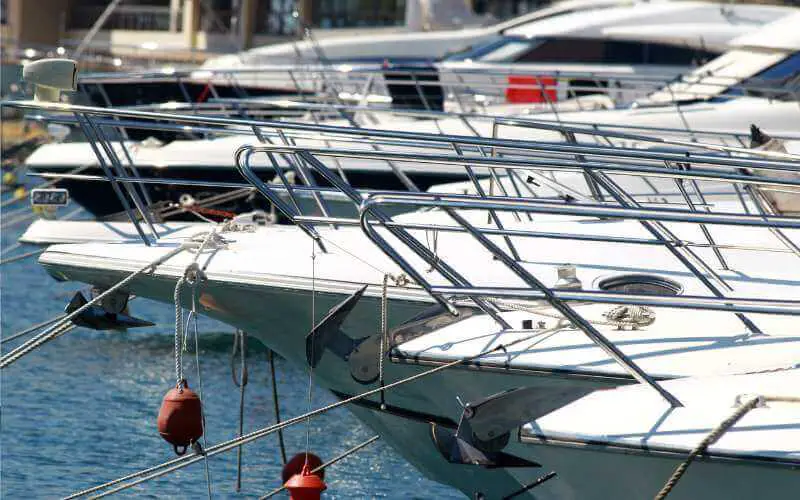
Differences in Power and Propulsion
When it comes to power and propulsion, yachts and boats have some key differences. Yachts are often equipped with larger, inboard engines designed for speed and endurance. In contrast, boats may have outboard motors that are smaller and better suited for recreational purposes.
Another key difference relates to the type of transmission used. Yachts often rely on multi-speed transmissions that allow the engine to operate at various speeds. Boats, on the other hand, may have simpler transmission systems that are designed for a lower level of performance.
The type of propulsion used is also important to consider. Yachts may be propelled by jets, controllable pitch propellers or other high-tech means, enabling them to perform well in various conditions. Boats typically rely on simpler propellers unsuited to more demanding environments.
Difference in Price
When it comes to price, yachts and boats are on opposite ends of the spectrum. Boats, being smaller and typically used for recreational purposes, can range from a few thousand dollars to a few hundred thousand dollars.
Yachts, on the other hand, are significantly more expensive. These vessels are often larger and more luxurious, costing several million to hundreds of millions of dollars.
The cost of owning a yacht goes beyond just the initial purchase price. Yachts require significant upkeep, including maintenance, insurance, and docking fees. However, yacht owners are often willing to pay high costs for the prestige and luxury of owning such vessels.
The Difference in Luxury and Comfort
Luxurious yachts have everything from plush interiors with high-end finishes to state-of-the-art entertainment systems. Many yachts also come equipped with luxurious bedrooms, bathrooms, and gourmet kitchens.
In addition to these features, yachts offer expansive decks and outdoor spaces for entertaining guests or simply enjoying the sun and sea breeze.
When it comes to luxury and comfort, there really is no comparison between a yacht and a boat. While boats may be functional for certain activities, such as fishing or water sports, they offer a different level of extravagance than you’ll find onboard a yacht.
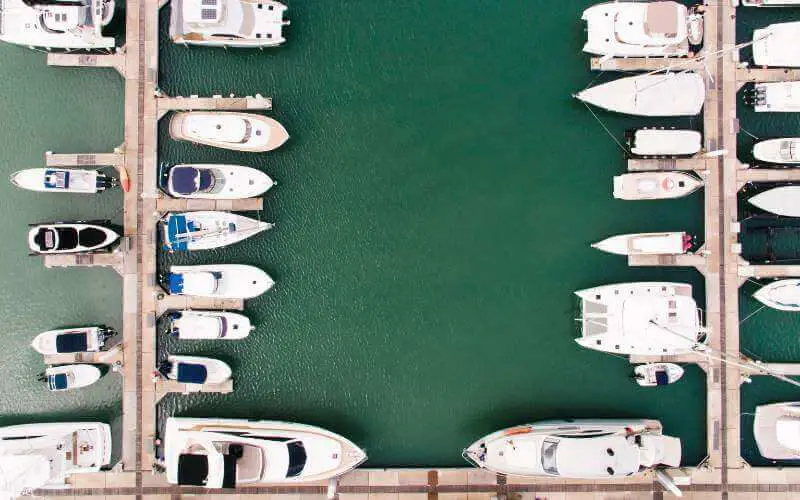
Frequently Asked Questions
What is the cost difference between purchasing a yacht and a boat.
Before you set sail, remember, a yacht is not just a bigger boat. The difference between purchasing a yacht and a boat can be significant, with yachts typically costing millions while boats range from thousands to hundreds of thousands.
Are there any legal requirements for operating a yacht versus a boat?
To operate a yacht, you may need a captain’s license and have to follow specific regulations depending on the size of your vessel. For boats, requirements vary by state and type of boat but are generally less strict.
How does the size of a yacht compare to the size of a boat?
Yachts are generally larger than typical boats, ranging from 33 feet to over 160 feet in length. However, the size distinction between a yacht and a boat needs to be clearly defined and can vary depending on personal perception.
Are there any specific maintenance requirements for a yacht that differ from those of a boat?
Yachts require meticulous maintenance to ensure they remain seaworthy. This includes regular inspections, cleaning, and repairs. These tasks are more complex and costly than those typically required for boats but crucial for the safety of all onboard.
What is the largest yacht in the world?
As of 2023, the largest yacht in the world is the SOMNIO , measuring 222 meters (728 feet) in length. The yacht is under construction and due for launch in mid-2024.
A yacht can be likened to a floating mansion, replete with lavish amenities and luxurious features, often owned by affluent individuals who relish time at sea. These vessels boast multiple decks, spacious cabins, and even swimming pools.
In contrast, boats come in various shapes and sizes, ranging from small dinghies to large commercial tugboats. While some boats offer basic amenities like a small cabin or restroom, they cannot compete with the luxury of a yacht.
The primary distinction between a yacht and a boat lies in luxury and comfort. Yachts epitomize extravagance, providing amenities akin to a high-end hotel suite, while boats prioritize practicality and functionality.
Ultimately, choosing between a yacht and a boat depends on personal preferences and intended use.
A Guide to Naming Your Boat: Finding the Perfect Name for Your Boat
Naming a boat is an important and personal decision every boat owner must make. Whether you have just purchased a

What is the Steering Wheel on a Ship Called?
The ship steering wheel holds a special place in maritime history, from tales of daring adventures on the high seas

Best Way to Avoid Overloading Your Boat and Keep Your Boat Capacity Under the Weight Limit
Embarking on a boating adventure brings a sense of excitement and freedom. However, ensuring the safety and stability of your
Workshop Insider Newsletter
Be a workshop insider get our latest collection of news and announcements delivered to your inbox..., latest articles.
- June 25, 2024
- Boats , Marine Engineering
- June 24, 2024
Navigating the Darkness: Understanding Boat Navigation Lights and the Different Types
Boat collisions: how to avoid collisions with another boat.
- September 12, 2023
The Ultimate Guide to Pipeliner Welding Hoods: Features, Benefits, Buying Guide, and Best Practices
- Welding Helmets Buying Guides
- September 11, 2023

- Privacy Policy
- Terms of Use
- Affiliate Disclosure

- Marine Engineering
- Yacht Services
- Yacht Surveys
- Yacht Electrician
- Megger Testing
- Marina Electrical Services
- Industrial Electrical
- Commercial Electrical
- Residential Building Electrical
- LED Lighting
- Industrial Lighting
- Electric Vehicle Charging Stations
- Sales & Parts
- Service Request
- Sales Request

- Privacy Policy
- Terms & Conditions
- RH Marine Group
What’s the Difference Between a Yacht and a Boat?
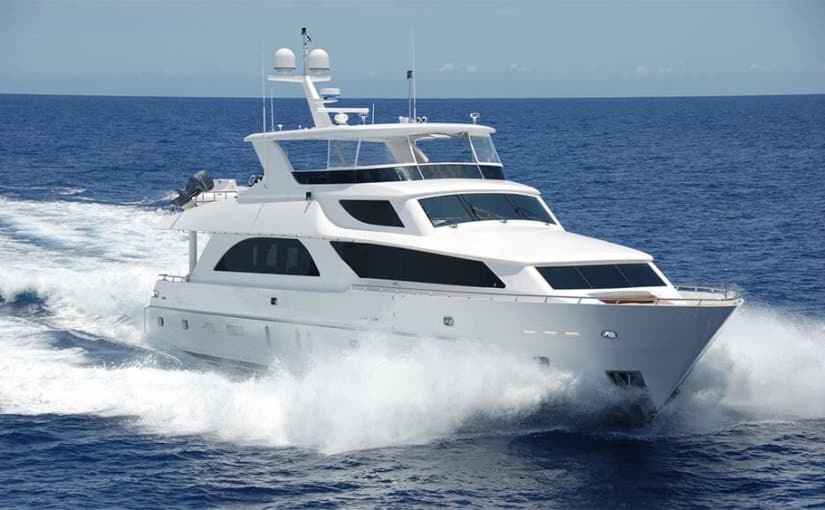
Many boating enthusiasts use the words boat and yacht interchangeably when in reality, they are very different terms. A yacht is a larger, recreational boat or ship. The word “Yacht” comes from Dutch origin and was originally defined as a light, and fast sailing vessel used by the Dutch navy to find and capture pirates. A boat, on the other hand, is smaller in size and can be anything from a fisherman’s boat to a sailboat.
When determining the difference between a yacht and a boat , there are a few main deciding factors including:
Size As previously mentioned, size matters when it comes to differentiating between a boat and a yacht. Yachts can range from about 35 feet in length all the way up to 160+ feet in length, however, most will be somewhere in the middle. Anything over 160 feet would be considered a “Superyacht”. Boats are generally anywhere from 15-30 feet in length.
Where they can operate Smaller boats are usually capable of operating in calm waters like lakes, rivers, and shallow harbors. Some larger boats, usually 20 – 30 feet in length, can also navigate more rough ocean waters. A yacht, on the other hand, is able to sail in deeper, ocean waters and deal with more turbulent seas. Due to a larger size, high tech yacht electronics and guidance instruments, protection from the elements, and a number of other features yachts are far more suitable for longer ocean trips.
Crew While a boat can be operated by just one captain, a yacht typically requires a full crew to help with navigation, maintenance, electronics and engineering, repairs and stewards to cater to the passengers. In reality, it’s a lot more like a small, private cruise service than an afternoon on the boat with your friends.
Propulsion Depending on the boat, it may operate solely using a sail and the wind, or one or more inboard or outboard motors. While some larger boats can mount very large engines to create some real speed on the water, these engines do not match the power of most yacht engines. Yacht engines are much larger in size, can produce considerably more power – in some cases up to 800hp, and are capable of running much longer distances.
Navigation and technology While some boats may have advanced marine electronics and navigation systems, it’s more of a requirement when it comes to yachts. When making trans oceanic trips it is not only important that you are able to navigate with precision, but also that you can detect other boats or objects that you may not be able to see and understand the performance of your vessel.
Tess Electric is a leading provider of marine electronics, marine electrical services , and marine engineering services to owners and crews of yachts and superyachts in Fort Lauderdale, FL. If you’re looking to work with an experienced team of marine electrical contractors, contact us today.
Recent Posts

We are a Marine Electrical Service Company servicing mostly in the Large Mega Yacht Industry and Marine Land Installations (marinas, resorts, apartments, docks, etc). We have mobile Technicians who cover the tri county area (Broward, Palm Beach and Dade) in their fleet of vehicles.

- Marine Electrical
- Land Division
- ShipServ Ship Supply
Our Services
- Fluorescent To LED Conversion
- All Land Services
- All Marine Services
Sales & Support
- Sales Request Form
Our Location
Tess Electrical LLC
- Office : (772)-217-6124
- Cell : (754)-367-3768
- Email : [email protected]

- Yacht Management
- Yacht Delivery
- Yacht Crew Placement
- Yacht Charters
- Yacht Provisioning
- Yacht Restorations
- Yacht Maintenance Contracts
- Yacht General Repairs
- Yacht Electrical Installation
- Yacht Re Power
- Yacht Emergency Response
- Yacht Financial Administration
- Yacht Technical Support
- Yacht 100 hour Service
- Yacht Ozone treatment
- Yacht Linen Service
- Yacht Membership
- Affiliation
A yacht is typically larger and more luxurious than a boat. Yachts are often privately owned and used for leisure activities, while boats can be used for various purposes such as fishing or transportation. Yachts usually have cabins, living spaces, and amenities like a kitchen and bathroom, while boats may have more basic features. Additionally, yachts require a crew to operate, while boats can be operated by a single person. Overall, the main difference is in size, luxury, and purpose.

Understanding the Distinction Between a Boat and a Yacht:
1. size matters: differentiating boats from yachts.
One of the most significant differences between a boat and a yacht is their size. While there is no universally agreed-upon threshold that defines when a boat becomes a yacht, a general guideline is to consider vessels longer than 40 feet as yachts. However, this guideline may vary depending on regional and industry standards.
Boats, on the other hand, are typically smaller in size compared to yachts. They can range from small recreational vessels, such as fishing boats or speedboats, to mid-sized cruisers used for leisure activities. Boats are designed for various purposes, including fishing, water sports, transportation, and recreation.
Yachts, with their larger size, offer more luxurious and spacious accommodations. They are often equipped with multiple decks, cabins, and amenities such as swimming pools, jacuzzis, and helipads. Yachts are designed for leisurely cruising and can be privately owned or chartered for extravagant vacations.
1.1 The Distinctions in Construction
When it comes to construction, boats and yachts can be made of different materials. Boats are commonly built using materials such as fiberglass, aluminum, or wood. These materials are lightweight and cost-effective, making boats more accessible and affordable for recreational purposes.
Yachts, on the other hand, are often constructed using high-quality materials such as steel or aluminum. These materials offer increased durability and stability, making them suitable for long-distance cruises and adverse weather conditions. Additionally, yachts may feature more intricate design elements and luxurious finishes.
The construction of yachts is typically more complex than that of boats. Yachts may incorporate advanced engineering systems for propulsion, navigation, and comfort. They often boast state-of-the-art technology and amenities, elevating the overall experience for those on board.
1.2 Purpose: Differentiating Factors
Another differentiating factor between boats and yachts is their purpose. Boats are primarily used for recreational activities and water sports. They are designed to be agile, maneuverable, and efficient in covering smaller distances. Boats are popular among fishing enthusiasts, water skiers, and day cruisers.

Yachts, on the other hand, are associated with luxury and leisure. They serve as private or charter vessels for extended cruising or extravagant vacations. Yachts offer a range of amenities and services, including fine dining, entertainment areas, and spacious living quarters. They are designed to provide a luxurious and comfortable experience for those on board.
The purpose of a yacht extends beyond recreation and water sports. Yachts can also be used for business meetings, corporate events, and even hosting parties and weddings. Their larger size and amenities make them suitable for hosting gatherings and creating memorable experiences.
2. Legal and Regulatory Considerations: Licensing and Flagging
Aside from size and purpose, there are also legal and regulatory factors that differentiate boats from yachts. These factors include licensing requirements and the process of flagging the vessel.
In many jurisdictions, boats do not require specific licensing if they are used for recreational purposes. However, regulations may vary, and individuals should familiarize themselves with their local laws and requirements regarding boat operation and licensing.
Yachts often fall under stricter regulations due to their size and commercial potential. Captains and crew members operating yachts may be required to hold specific licenses and certifications, especially when operating in international waters. The licensing requirements may include qualifications in navigation, safety procedures, and emergency response.
An additional consideration for yacht owners is the process of flagging the vessel. Flagging refers to registering the yacht under the flag of a specific country. The chosen flag state will determine the legal, regulatory, and tax implications for the yacht owner. The choice of flag may have implications on the yacht’s operational restrictions, crew requirements, and taxation obligations.
2.1 The Importance of Flagging
Flagging is an essential process for yacht owners as it establishes the legal status and nationality of the vessel. The choice of flag also affects the yacht’s ability to navigate certain waters, enter ports, and comply with international regulations. Yacht owners often consider factors such as the flag state’s reputation, the yacht’s intended cruising areas, and the tax implications associated with flagging.

Popular flag states for yacht registration include countries such as the British Virgin Islands, Cayman Islands, Malta, and the Marshall Islands. These flag states offer favorable regulations, tax incentives, and a well-established yacht registration process.
3. Price and Ownership: Financial Considerations
Price and ownership are significant factors when distinguishing between boats and yachts . The cost of a vessel is influenced by various factors, including size, construction materials, amenities, and brand reputation.
Boats, being smaller and simpler in design, are generally more affordable than yachts. The price range for boats can vary widely, ranging from a few thousand dollars for small recreational boats to several million dollars for high-performance or luxury boats.
Yachts, due to their larger size, luxurious amenities, and high-quality construction, can have significantly higher price tags. The cost of purchasing a yacht can range from several hundred thousand dollars to several hundred million dollars, depending on factors such as length, brand, customization, and onboard features.
3.1 Ownership and Maintenance Costs
Ownership costs also differ between boats and yachts. Boats, especially smaller recreational vessels, generally have lower maintenance costs. They require less fuel and typically have fewer systems and amenities to maintain.
Yachts, as more complex and larger vessels, have higher ownership and maintenance costs. Fuel expenses can be significant due to their size and engine power. Additionally, the maintenance and servicing of advanced systems, luxury finishes, and amenities contribute to the overall cost of yacht ownership.
Other cost considerations for yacht owners include crew salaries, marina fees, insurance, and necessary periodic surveys and certifications. Yacht owners must also allocate a budget for ongoing maintenance and unforeseen repairs.
Exploring Different Dimensions: Performance and Usage
While the above sections cover significant aspects of the distinction between boats and yachts, it is important to recognize that there are multiple dimensions to consider when comparing the two. Performance and usage are two such dimensions that shed further light on the differences.

1. Performance: Speed, Efficiency, and Maneuverability
Performance is a crucial factor to differentiate between boats and yachts. Boats, particularly those designed for specific activities such as fishing or water sports, prioritize speed, agility, and maneuverability. These vessels are typically equipped with powerful engines and have hull designs that optimize speed and stability.
Yachts, while capable of decent speeds, prioritize comfort and stability over speed alone. They are built to handle longer voyages and adverse weather conditions while providing a smooth and comfortable experience for those on board. Yachts have a more balanced design that focuses on factors such as fuel efficiency, seakeeping, and reduced noise and vibration levels.
1.1 The Role of Hull Design
The design of the hull significantly impacts the performance of both boats and yachts. Boats often have planing hulls, which allow them to rise and glide on top of the water at high speeds. These hulls feature a flatter bottom, allowing the boat to gain speed and maneuver easily.
Yachts, depending on their purpose, may have different types of hull designs. Displacement hulls are commonly found on larger yachts and prioritize fuel efficiency and stability. These hulls move through the water instead of planing on top of it. Yachts designed for higher speeds may have semi-displacement or planing hulls, allowing for a balance between efficiency and speed.
2. Usage: Recreational and Commercial Applications
The usage of boats and yachts varies depending on their design and capabilities. Boats are predominantly used for recreational purposes and are associated with activities such as fishing, water skiing, wakeboarding, and day cruising. They are versatile vessels that cater to a wide range of recreational needs and are often used for personal enjoyment and water-based sports.
Yachts , while also used for recreational purposes, offer a broader range of applications. They are commonly chartered for leisurely vacations, providing a luxurious experience for guests. Additionally, yachts can be used for corporate events, business meetings, and even as venues for weddings and parties. Their larger size and amenities allow for a more versatile and multifunctional experience.
2.1 Commercial Aspects of Yachts
Yachts can also be involved in commercial applications beyond recreational charters. Some yachts are used as research vessels, expedition platforms, or even as floating hotels for major events or conferences. These commercial applications showcase the versatility and adaptability of yachts beyond their traditional recreational role.
In summary, while boats primarily serve recreational purposes, yachts offer a broader range of applications, including luxury vacations, corporate events, and commercial ventures.

In conclusion, while the terms “boat” and “yacht” are often used interchangeably, there are clear distinctions between the two. These distinctions include size, construction , purpose, legal considerations, price, ownership costs, performance, and usage. Understanding these differences allows individuals to make more informed decisions when it comes to choosing the right vessel for their needs, whether it be a boat for recreational activities or a yacht for luxurious cruising and hosting memorable experiences.
Key Takeaways:
- A boat refers to any small or medium-sized watercraft used for recreational activities or transportation.
- A yacht, on the other hand, is a larger, more luxurious vessel typically used for leisure and pleasure.
- The size of a boat is generally smaller, while a yacht is much larger and can have multiple decks.
- Boats are commonly used for fishing, watersports, and short trips, while yachts are designed for longer cruises and often equipped with luxurious amenities.
- In terms of cost, boats are generally more affordable, while yachts can be quite expensive to purchase and maintain.
Frequently Asked Questions
Boats and yachts are both types of watercraft, but there are differences that set them apart. Below are some frequently asked questions about the difference between a boat and a yacht:
What distinguishes a boat from a yacht?
The main distinction between a boat and a yacht lies in their size and purpose. A boat is generally smaller and designed for recreational activities such as fishing, water sports, or leisurely cruising. On the other hand, a yacht is larger and often built for luxury, comfort, and long-distance travel.
While the specific length requirement may vary, a vessel is typically considered a yacht if it exceeds 40 feet in length. Boats, on the other hand, can range from small dinghies to medium-sized pleasure crafts.
Do boats and yachts have different features?
Boats and yachts generally have similar components and functionalities, but yachts often boast additional amenities and features. Yachts are equipped with luxurious cabins, spacious decks, multiple lounging areas, and often include amenities such as swimming pools, Jacuzzis, and even helipads. Boats, while still providing comfort and functionality, may have a more simplistic design and fewer luxurious extras.
It’s important to note that there are varying sizes and types of boats and yachts, so features can differ greatly depending on the specific vessel.
In summary , the main difference between a boat and a yacht lies in their size and purpose. A boat is a broad term that encompasses various types of watercraft, often used for recreational activities or transportation. On the other hand, a yacht refers to a larger, more luxurious vessel that is typically used for leisure and pleasure.
Boats are generally smaller in size and have a simpler design compared to yachts. They are often used for fishing, water sports, or cruising in inland waters. Yachts, on the other hand, are larger and more extravagant, often featuring luxurious amenities and accommodations. They are designed for extended stays at sea, offering a comfortable and lavish experience for their owners and guests.
- The Inventory
- Beyond Cars

When Is a Ship a Yacht, and When Is It Not?
The difference between the two broad categories is determined by one key factor..
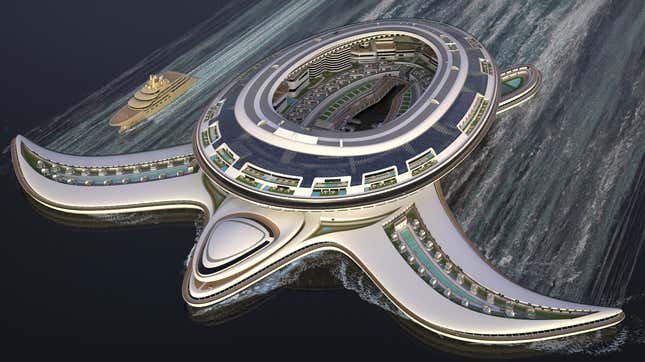
Yachts have been in the news a lot more frequently in recent years. There have been stories like when a Dutch yacht builder requested to temporarily dismantle an iconic bridge in Rotterdam to get a 417-foot-long sailing yacht commissioned by Jeff Bezos out to sea, or when authorities around the world seized the yachts of Russian oligarchs in the wake of Russia’s invasion of Ukraine. Usually, the most notable yachts have the prefixes super-, mega- and even giga- attached to convey their truly enormous sizes relative to most other privately-owned vessels.
Suggested Reading
As a result, ‘yacht’ as a term has basically become meaningless just by the sheer proliferation of private ships in recent years that defy all potential superlatives. It’s like when you say a word so often that it loses all its meaning. Why are there so many more huge luxury maritime vessels in the world? Rising levels of global wealth inequality? Technical innovation? I don’t know. The Pangeos is the latest planned monument to ostentatious wealth. The 1970-foot-long turtle-shaped ship is the brainchild of Italian designer Pierpaolo Lazzarini. However, this self-declared terayacht is not a yacht by definition.
Related Content
The only distinction between a yacht and a ship is simple: It is the vessel’s intended purpose. When you enter a foreign country, every customs agent will ask, “What is the purpose of your trip, business or pleasure?” It is the same when categorizing large water vehicles. The sole purpose of a yacht is recreation. If the craft has any other intended purpose, such as naval warfare or maritime commerce, it’s a ship. The U.S.S. Gerald R. Ford , a nuclear-powered U.S. Navy aircraft carrier, and the Carnival Celebration, a 5,280-passenger Carnival cruise ship , are both ships.
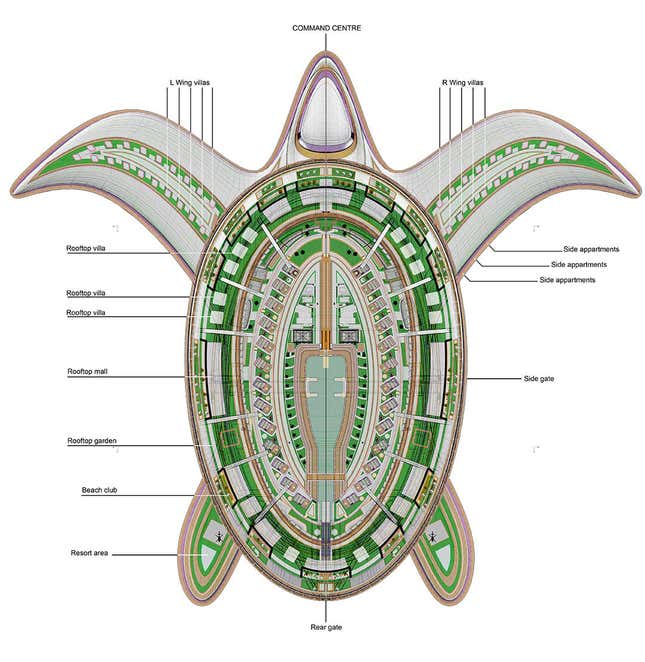
The plans for the Pangeos might feature private vacation villas and apartments. However, the absurd craft would also include also shopping malls and a hotel resort, making the Pangeos a ship. The Pangeos, named after the prehistoric supercontinent of Pangea, will likely never be built due to the ship’s $8 billion price tag.
Besides ship and yacht, boat is another commonly used term. The definition of a boat is much more vague and open to interpretation. Boats tend to be small personal craft and only carry a few people. Though, it’s common for sailors to refer to vessels of any size or purpose as a boat.
Boat Pursuits
What’s the difference between a yacht and superyacht (a closer look).
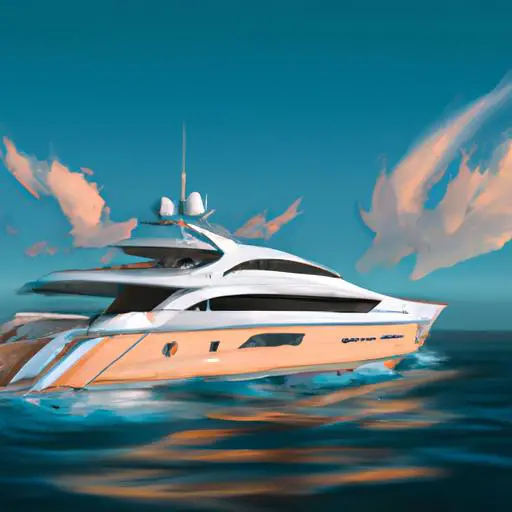
Are you in the market for a luxurious boat but aren’t sure if a yacht or superyacht is right for you? Every boat aficionado knows there’s a major difference between these two vessels, but what is it? In this article, we’ll take a closer look at the differences between yachts and superyachts, from size, cost, and amenities, to the pros and cons of each.
You’ll have a better understanding of the differences between the two vessels and be able to make an informed decision about which one to purchase.
So, let’s dive in and compare yachts and superyachts!.
Table of Contents
Short Answer
A yacht is a large recreational vessel that is typically used for sailing and cruising.
Generally, yachts are smaller than 80 feet in length.
A superyacht is a luxury vessel that is typically over 80 feet in length and is often used for charter or commercial purposes.
Superyachts often feature multiple levels, advanced technology and amenities, and much larger cabins and staterooms.
Superyachts are usually much more expensive than yachts, and require a larger crew to operate.
Definition of Yachts
Yachts are luxurious vessels that are used for recreational activities such as sailing, cruising, and leisurely trips.
They come in a variety of sizes, although they are typically smaller than superyachts and range from 24 to 80 feet in length.
Yachts are typically characterized by their sleek, modern designs and are a popular choice among those looking for a luxurious experience on the open water.
Yachts provide a range of amenities, from comfortable cabins and spacious decks to state-of-the-art navigation and entertainment systems.
They also come with a variety of features designed for safety and convenience, such as side and stern thrusters, bow and stern thrusters, and advanced sailing and navigational systems.
Yachts also offer a range of recreational activities such as fishing, diving, water skiing, and kayaking.
Yachts are an affordable option for those looking to experience the luxury of the open waters without breaking the bank.
They provide a great way to explore the world while still enjoying the comforts of home.
Definition of Superyachts

When it comes to the world of luxury vessels, superyachts are the cream of the crop.
A superyacht is a large, luxurious vessel, typically bigger than 80 feet in length, that is used primarily for recreational activities such as sailing and leisurely cruising.
Superyachts are often associated with the wealthiest people in the world and offer a higher level of luxury, comfort, and amenities than a traditional yacht.
Superyachts are designed and built with the latest advancements in navigational and sailing technology.
These vessels feature advanced features like gyroscopic stabilization systems, dynamic positioning systems, and advanced satellite navigation systems to ensure their owners have a safe and comfortable journey.
Superyachts also come with a variety of amenities, such as spacious cabins and suites, multiple decks, hot tubs, private pools, and much more.
All of these features come together to create an exclusive and luxurious experience that is second-to-none.
The cost of a superyacht can vary greatly depending on its size, features, and design.
Superyachts can range from anywhere between $10 million to over $100 million, making them far more expensive than traditional yachts.
For this reason, superyachts are often only available to those with the means to purchase or charter one.
In conclusion, superyachts are larger and more luxurious vessels than traditional yachts, offering a higher level of comfort and amenities.
They are also much more expensive, and are often only accessible to the wealthiest people in the world.
But for those who can afford it, superyachts offer an exclusive and luxurious experience that is second-to-none.
Size Comparison of Yachts and Superyachts
When it comes to the difference between yachts and superyachts, size is one of the most prominent distinguishing factors.
Yachts typically range from around 24 to 80 feet in length, while superyachts are much larger, often exceeding 200 feet in length.
These larger vessels offer a much more luxurious experience than their smaller counterparts, and come with a much higher price tag.
Another difference between yachts and superyachts is the level of luxury they offer.
Superyachts provide a much more luxurious experience, often featuring higher-end amenities such as spas, helipads, and swimming pools.
They also come with a range of advanced navigational and sailing technology, such as gyroscopic stabilization systems, advanced satellite navigation systems, and more.
The larger size of superyachts also allows them to travel farther than yachts, often allowing them to visit ports and destinations that would be inaccessible to smaller vessels.
This means that superyachts are ideal for taking longer trips, such as those that last for weeks or even months.
Finally, superyachts are much more exclusive than yachts, as there are far fewer of them on the market.
This means that those who can afford to purchase a superyacht are likely to feel a sense of exclusivity and privilege that comes with owning such a vessel.
Ultimately, its clear that there are a number of differences between yachts and superyachts.
While yachts offer a luxurious experience, superyachts take this experience to the next level, providing a much more exclusive and luxurious experience.
From size and amenities to navigation and sailing technology, superyachts offer a unique and luxurious experience that is unlike any other.
Cost Comparison of Yachts and Superyachts

When it comes to the differences between yachts and superyachts, cost is one of the biggest distinguishing factors.
Yachts are typically much more affordable than superyachts, with smaller vessels ranging from around 24 to 80 feet in length costing anywhere from $50,000 to $2 million.
On the other hand, superyachts are much more expensive, with vessels longer than 200 feet costing anywhere from $5 million to $400 million.
The cost of a superyacht largely depends on the size and features of the vessel.
Superyachts offer a much higher level of luxury, comfort and amenities than yachts, and are typically outfitted with the latest navigational and sailing technology, such as gyroscopic stabilization systems and advanced satellite navigation systems.
As such, they often come with a much higher price tag.
In addition to the cost of the vessel itself, there are also the associated costs of maintenance and ownership that need to be taken into account.
Superyachts typically require a much larger crew and cost more to maintain due to their size and complexity.
As such, owning a superyacht can be a costly endeavor, but one that many believe to be worth it for the luxury experience it provides.
In conclusion, there is a clear difference between yachts and superyachts, with cost being one of the most notable.
Yachts are typically much more affordable than superyachts, and offer a basic level of luxury and comfort, whereas superyachts offer a much higher level of luxury, comfort and amenities, and come with a much higher price tag.
Luxurious Amenities Offered by Superyachts
When it comes to luxury and comfort, superyachts are in a league of their own.
Superyachts are typically much larger than yachts, with some exceeding 200 feet in length, and they offer a higher level of amenities and comforts than yachts can.
Superyachts offer spacious living areas, fully equipped galleys, and all the amenities one would expect from a luxury cruise ship.
Superyacht owners also enjoy access to private pools, hot tubs, and spas, as well as a wide array of entertainment options.
Superyachts are designed with advanced navigational and sailing technology that make them perfect for long-distance cruising.
These vessels feature gyroscopic stabilization systems, which reduce the amount of rolling and pitching that can occur due to the movement of the ocean.
They also feature advanced satellite navigation systems and the latest in automated piloting technology, allowing them to sail safely and efficiently in any weather condition.
Superyachts also feature luxurious interiors that rival the best hotels and resorts.
Superyacht owners can enjoy cabin suites with private balconies, gourmet kitchens, and even private cinemas.
Superyachts also feature a variety of amenities and activities, such as swimming pools, waterslides, and even on-board karaoke bars.
In addition to the amenities and technology, superyachts also come with a team of highly trained and experienced crew members.
These crew members are responsible for the overall safety and comfort of the passengers and can provide a variety of services, from cooking to cleaning.
They can also assist passengers with any special requests they may have, such as arranging for a private chef or arranging for special activities.
Whether you’re looking for a luxurious vacation or a chance to explore the open seas, a superyacht is the perfect choice.
With its advanced navigation and sailing technology, luxurious amenities, and experienced crew, a superyacht provides a unique and unforgettable experience.
So, if you’re ready to experience the best of luxury and comfort, be sure to consider a superyacht.
Advanced Technology Found in Superyachts

When it comes to the luxurious vessels known as superyachts, advanced technology is one of the main features that sets them apart from yachts.
Superyachts are equipped with a variety of advanced technologies that can make sailing and cruising comfortable, efficient, and enjoyable.
For starters, superyachts often feature gyroscopic stabilization systems, which help keep the vessel stable even in rough seas.
These systems use multiple advanced sensors to detect any signs of instability and automatically adjust the vessel’s position accordingly.
This helps reduce motion sickness and makes for a more pleasant experience.
Superyachts also come with advanced satellite navigation systems.
These systems use GPS data combined with detailed nautical charts to give the captain accurate information about the vessel’s location, speed, and heading.
This helps the captain make informed decisions about their route and can help them avoid dangerous waters.
Finally, superyachts also come equipped with advanced communication systems.
These systems allow the captain and crew to stay in touch with the outside world, even when they are out at sea.
They also allow them to access up-to-date weather information and get assistance in case of an emergency.
When it comes to the differences between yachts and superyachts, the advanced technology found in superyachts is one of the main factors that sets them apart.
Superyachts offer a much more luxurious and comfortable experience, and the advanced technology found in these vessels makes this experience even more enjoyable.
Whether it’s for a leisurely cruise or a long-distance voyage, superyachts offer a level of luxury and comfort that yachts simply cannot match.
Pros & Cons of Yachts and Superyachts
Yachts and superyachts are both luxurious vessels that provide a unique and enjoyable experience for recreational activities, such as sailing and leisurely cruising.
However, each type of vessel has its own unique pros and cons.
Yachts, which typically range from around 24 to 80 feet in length, offer a more affordable option for those who are looking to enjoy sailing and cruising.
They are also generally easier to handle and maneuver due to their smaller size.
Additionally, some yachts are designed specifically for racing and can be quite fast.
On the other hand, superyachts, which can exceed 200 feet in length, offer a much more exclusive and luxurious experience.
They are more expensive, but they come with a higher level of luxury, comfort, and amenities.
Superyachts also feature more advanced navigational and sailing technology, such as gyroscopic stabilization systems and advanced satellite navigation systems.
This can be particularly beneficial for those who are looking for a more secure and comfortable experience.
Overall, yachts and superyachts each have their own unique pros and cons.
Yachts are a more affordable option and are easier to handle, while superyachts offer a much more luxurious experience with more advanced technology.
Ultimately, the choice between a yacht and a superyacht depends on the individuals budget and needs.
Final Thoughts
Yachts and superyachts both offer a luxurious experience for sailing and leisure activities, but there are some key differences between the two.
Yachts are typically smaller and less expensive, while superyachts are much larger, more expensive, and offer a higher level of luxury, comfort and amenities.
Superyachts also feature more advanced navigational and sailing technology.
Whether you choose a yacht or a superyacht, you are sure to have a luxurious experience.
However, if you want the ultimate in luxury and comfort, then a superyacht is the way to go.
So, if you’re looking for a luxurious experience on the open seas, be sure to do your research on yachts and superyachts to find the perfect vessel for you.
James Frami
At the age of 15, he and four other friends from his neighborhood constructed their first boat. He has been sailing for almost 30 years and has a wealth of knowledge that he wants to share with others.
Recent Posts
When Was Banana Boat Song Released? (HISTORICAL INSIGHTS)
The "Banana Boat Song" was released in 1956 by Harry Belafonte. This calypso-style song, also known as "Day-O," became a huge hit and remains popular to this day for its catchy tune and upbeat...
How to Make Banana Boat Smoothie King? (DELICIOUS RECIPE REVEALED)
To make a Banana Boat Smoothie King smoothie at home, start by gathering the ingredients: a ripe banana, peanut butter, chocolate protein powder, almond milk, and ice. Blend the banana, a scoop of...
- Organizations
- Planning & Activities
- Product & Services
- Structure & Systems
- Career & Education
- Entertainment
- Fashion & Beauty
- Political Institutions
- SmartPhones
- Protocols & Formats
- Communication
- Web Applications
- Household Equipments
- Career and Certifications
- Diet & Fitness
- Mathematics & Statistics
- Processed Foods
- Vegetables & Fruits
Difference Between Yacht and Boat
• Categorized under Objects | Difference Between Yacht and Boat

English is a language that is choc full of words. In fact, English has one of the largest vocabularies of any of the world’s languages. While this makes it a rich and fascinating language, it can also make learning English somewhat confusing.
Take for instance the amount of vocabulary that we have to differentiate between marine vessels. What exactly is the difference between a yacht and a boat?
English speakers generally use the word boat to refer to a sea vessel that is reasonably small and not luxurious. The term can refer to a vessel that is motorized or not motorized and either used for work, such as in the case of a fisherman or water police, or for recreational purposes such as weekend fishing or relaxing.
A boat can either be a dinghy, row boat, fishing boat, or sailing boat and they can be quite large, but are usually more practical than luxurious.
A yacht is normally a larger and much more luxurious sea vessel than a boat. Tell the owner of a yacht that they have a boat and they are likely to take offense. Yachts are not generally used for commercial purposes, but are luxury recreational vessels. They can either be sailing yachts or power boat yachts.
There are a couple of different styles of yacht that can be differentiated: a regular yacht starts at about 34 feet, a mega yacht is more than 100 feet and a super yacht is any yacht that is longer than 200 feet.
A ship is a very large sea vessel that is generally used for commercial purposes such as shipping cargo between ports around the world or a cruise ship or passenger ship for transporting people.
There is a lot of different vocabulary used to describe different types of sea going vessels, but if you understand the essential differences between a boat, ship and yacht then you are unlikely to make many errors. Boat tends to be a broader term for sea vessels than yachts, which are more specifically used as a luxury pastime.
Summary: 1.Boats can be used for commercial or recreational purposes 2.Yachts are generally only recreational 3.Boats are generally small 4.Yachts can be any size up to more than 200 feet long 5.Ships are large sea vessels used for commercial purposes 6.Boats and yachts can either be motorized or not motorized
- Recent Posts
- Difference Between Governor and Senator - November 14, 2009
- Difference Between Immigration and Migration - November 14, 2009
- Difference Between Who and Whom - November 13, 2009
Sharing is caring!
Search DifferenceBetween.net :
- Difference Between Boats and Ships
- Difference Between Port and Harbor
- Difference Between Aluminum and Fiberglass Boats
- Difference Between MPH and Knot
- Difference Between Inboard and Outboard Motors
Cite APA 7 , R. (2009, November 3). Difference Between Yacht and Boat. Difference Between Similar Terms and Objects. http://www.differencebetween.net/object/difference-between-yacht-and-boat/. MLA 8 , Rachel. "Difference Between Yacht and Boat." Difference Between Similar Terms and Objects, 3 November, 2009, http://www.differencebetween.net/object/difference-between-yacht-and-boat/.
US Coast Guard conciders a vessel over 26′ with a cabin to be a yacht.
All Boats for privat sporting are named “YACHT”. For me is a Yacht a sportboat with a closed cabin on board. per exemple : A safeboat on a liner is more long than 34 Feet but it is always a “BOAT” because its a public and commercial thing. A “Yacht” is a privat and luxury sportboat for a privat person !
Leave a Response
Name ( required )
Email ( required )
Please note: comment moderation is enabled and may delay your comment. There is no need to resubmit your comment.
Notify me of followup comments via e-mail
Written by : Rachel. and updated on 2009, November 3 Articles on DifferenceBetween.net are general information, and are not intended to substitute for professional advice. The information is "AS IS", "WITH ALL FAULTS". User assumes all risk of use, damage, or injury. You agree that we have no liability for any damages.
Advertisments
More in 'objects'.
- Difference Between Running Shoes and Walking Shoes
- Difference Between Club Soda And Tonic Water
- Difference Between CNG And LPG
- Difference Between Classical and Acoustic Guitar
- Difference Between Cat5e and Cat6
Top Difference Betweens
Get new comparisons in your inbox:, most emailed comparisons, editor's picks.
- Difference Between MAC and IP Address
- Difference Between Platinum and White Gold
- Difference Between Civil and Criminal Law
- Difference Between GRE and GMAT
- Difference Between Immigrants and Refugees
- Difference Between DNS and DHCP
- Difference Between Computer Engineering and Computer Science
- Difference Between Men and Women
- Difference Between Book value and Market value
- Difference Between Red and White wine
- Difference Between Depreciation and Amortization
- Difference Between Bank and Credit Union
- Difference Between White Eggs and Brown Eggs
Waterspouts are common in Florida. One might have led to seven deaths in Italy this week
Seven people died this week near Palermo, Italy when a 184-feet-long luxury sail boat capsized and rapidly sank after being struck by a pre-dawn storm on Monday (Aug. 21). The boat was carrying 22 passengers and crew.
It is believed the ship named Bayesian was struck by a tornado over the water - otherwise known as a waterspout - causing Bayesian to capsize. Other factors may have contributed.
In Southwest Florida and other places in the Sunshine State waterspouts are a common. The warm waters and humidity around Florida and the Gulf Coast are ideal for waterspout formation so we get more than our fair share.
What is a waterspout?
According to the National Weather Service , a waterspout is a swirling column of air and water mist. Waterspouts can grow to diameters of over 300 feet and last for up to an hour, though they usually only last from 5 to 10 minutes.
More: Divers find body of Mike Lynch's daughter Hannah, 18, missing after superyacht sank
What's the difference between a waterspout and a tornado?
Depends on what kind of waterspout you have. There are two kinds:
Tornadic waterspouts are simply tornados that formed over water, or that moved from land to the water. They usually come along with severe thunderstorms, high winds and seas, hail, and often a lot of lightning.
Fair weather waterspouts are much more common, especially from late spring to early fall, and much less dangerous. They generally form along the base of developing cumulus clouds when showers and non-severe thunderstorms are forming, but they aren't connected to storms or even high winds. You can get fair weather waterspouts whenever you have really humid conditions and water that's warmer than the air. Think of a really big, misty dirt devil.
Why does Florida get so many waterspouts?
Waterspouts are common in tropical and subtropical areas and along with Florida have been seen in the Great Lakes, the Mediterranean Sea, off the coast of Australia and elsewhere.
But if you really want to see lots of them, head to the Florida Keys where the waters there, especially from Marathon past Key West on westward to the Dry Tortugas , may see 400 to 500 waterspouts a year according to NOAA meteorologist and waterspout expert Dr. Joseph Golden, who called the Keys the "greatest, natural vortex lab in the world."
What's the difference between a waterspout and a funnel cloud?
A funnel cloud is a column of rotating air and water mist that is coming down from the bottom of a cloud but hasn't touched ground or water yet. Tornadoes and tornadic waterspouts both start out as funnel clouds.
Fair weather waterspouts start at the water level and grow upward toward the clouds so they never actually pass through the funnel cloud stage.
Are waterspouts dangerous?
Tornadic waterspouts are extremely dangerous, with tremendous force and windspeed, and should be treated as tornadoes.
Fair weather waterspouts tend to form under slow-moving clouds so they don't move very far or very fast, and they dissipate quickly over land.
What should I do if I see a waterspout?
If you're on land or swimming, watch the column carefully for movement and be prepared to leave the area if the waterspout appears to be moving quickly.
If you're in a boat, move at a 90-degree angle to the waterspout's apparent movement. Never move closer to get a better look, and never try to navigate through a waterspout. Even if they're weaker than tornados fair weather waterspouts can still do significant damage to you and your boat.
Listen for special marine warnings about waterspout sightings that are broadcast on NOAA Weather Radio .
672 Wine Club
- Motorcycles
- Car of the Month
- Destinations
- Men’s Fashion
- Watch Collector
- Art & Collectibles
- Vacation Homes
- Celebrity Homes
- New Construction
- Home Design
- Electronics
- Fine Dining
- Benchmark Wines
- Brian Fox Art
- Chase United
- Disneyland Resort
- Gateway Bronco
- Royal Salute
- Sports & Leisure
- Health & Wellness
- Best of the Best
- The Ultimate Gift Guide
- Rescuers Find Remaining Missing Aboard the Sunken ‘Bayesian’ Superyacht
Six bodies have been recovered, while local authorities push for investigations that could result in manslaughter charges.
Michael verdon, michael verdon's most recent stories.
- Jeff Bezos May Be the Owner of a New $80 Million Gulfstream Jet
- President Biden Finally Took the First Flight in the Long-Delayed ‘Marine One’ Helicopter
- Share This Article

Related Stories
- Acura Is Working on an All-Electric Sports Car to Replace the NSX
- BMW Just Sold More EVs In Europe Than Tesla for the First Time
- ‘They Should Feel Like They’ve Risked Death’: The Hypercar Startup That Wants to Deliver Old-School Fear on the Road
The boat’s rapid sinking happened at about 4 a.m. local time on Monday, after a waterspout, or a small, localized tornado on the water, caused the vessel to heel over and eventually capsize, sending it about 165 feet to the bottom of the Mediterranean. Fifteen people were rescued by a nearby vessel. Authorities identified the body of Recaldo Thomas, a Canadian Antiguan, who worked as the sailing yacht’s chef.
The celebratory trip aboard Bayesian took place shortly after Lynch was acquitted of fraud charges in the U.S. in a long-running legal battle against accusations that he had defrauded Hewlett-Packard after he sold Hewlett his company, Autonomy, for $11 billion.

Boat International has quoted a crew member as saying that the boat was struck by a freak weather event, which caused it to heel 20 degrees on its right side. It continued to heel until it began to take on water and sank in just 12 minutes. “We just didn’t see it coming,” Capt. James Calfield told Italian media.
A number of experts have speculated that water entering through the top via open hatches could have caused the sinking. Some witnesses have said that the mast snapped before the boat sank, but divers report the vessel is intact on the sea bottom.
Dario Boote, a ship structures and naval architecture professor at the University of Genoa, told paper that he expects a series of lawsuits to determine responsibility. “Clearly, only once the wreck is raised will we know more,” he told the
Read More On:
- Perini Navi
- Sailing Superyacht
- Superyacht Disaster
More Marine

This Revamped 161-Foot Trinity Superyacht Could Be Yours for $16 Million

Tech Mogul Mike Lynch and 5 Others Are Missing After a Yacht Sinks in Italy

A Fleet of Candela’s Electric Foiling Yachts Is Rolling Out to the Red Sea in 2025

This New 116-Foot Pocket Explorer Will Make Larger Expedition Yachts Jealous

Meet the Wine Club That Thinks Differently.
Receive editor-curated reds from boutique California producers four times a year.
Give the Gift of Luxury
Latest Galleries in Marine

‘La Dea II’ Superyacht in Photos

12 Must-See Yacht Debuts at This Year’s Cannes Fest
More from our brands, betty halbreich, bergdorf’s legendary personal shopper, dies at 96, most valuable nfl teams 2024: cowboys first to top $10 billion, ‘ripley,’ ‘fallout,’ ‘fargo’ and ‘oppenheimer’ take top honors at location managers guild awards, christie’s first sale at new asia headquarters led by $35 m. monet, the best yoga mats for any practice, according to instructors.
- Entertainment
- Other Sports
Bayesian yacht sinking: The key questions for investigators as probes underway
Investigators will face a number of key questions as they probe the sinking of the British-flagged Bayesian off the coast of Sicily .
A body believed to be that of Mike Lynch's 18-year-old daughter Hannah was recovered from the wreckage of the luxury yacht off the coast of Sicily on Friday.
Mr Lynch, Hannah, Morgan Stanley International bank chairman Jonathan Bloomer, his wife Judy Bloomer, Clifford Chance lawyer Chris Morvillo, and his wife Neda Morvillo were all lost when the ship sank. If confirmed to be Hannah all missing passengers have now been found.The body of the yacht ’s chef, Recaldo Thomas, was located shortly after the vessel sank.
Italian prosecutors have opened a criminal investigation. Investigators from the public prosecutor's office in the Sicilian town of Termini Imerese are collecting evidence for the probe.
The UK's Marine Accident Investigation Branch (MAIB) has deployed a team of inspectors to Italy.
The MAIB does not look to establish blame or liability but seeks to discover the causes of accidents at sea and prevent similar incidents in future.As investigators probe the aftermath of the incident, the Standard takes a look at key questions they will look into:
Did the yacht's design contribute to sinking?
The Bayesian has a mast measuring 72 metres, making it one of the largest in the world among sailing yachts.
Sam Jefferson, editor of the magazine Sailing Today, said the mast may have "acted almost like a sail" when severe weather hit the vessel, causing it to be "pinned over on its side".
Why did it sink so quickly and were the portholes open?
Mr Jefferson said he suspects "all the doors were open because it was hot", causing the yacht to fill with water "very quickly".
Weather records show temperatures reached around 33C the day before the sinking, which may have led to the vessel's occupants keeping access points open overnight.
Was the keel up? And if so, why?
Italian media reported that divers found the Bayesian's keel - a flat blade on the bottom of yachts that sticks down into the water to boost stability - was partially retracted.
Some yacht safety experts believe that may have contributed to the sinking.
But the Telegraph reported that a spokesperson for Italian Sea Group, which owns the company that built Bayesian, said: "Even without the keel completely out, the ship is stable and only a massive entry of water could have caused the sinking."
What measures did the crew take against the threat of bad weather?
Captain of the Bayesian, James Cutfield, told Italian media that he couldn't have foreseen the extent of the storm , saying “We didn't see it coming”.
Luca Mercalli, the president of the Italian Meteorological Society, said on Tuesday that the crew should have made sure that all the guests were awake and assigned them lifejackets, given the poor forecast.
Will the yacht be salvaged?
Nick Barke, head of salvage operations at Boats.co.uk, a boat sales and services company, said that the "only real way of knowing" why the yacht sank will be to lift it to the surface, but that would be "expensive and complicated process", likely to involve a crane barge.
He said divers would attach straps to the boat before it is lifted upright and then hauled out of the water.
He predicted this would be "time-consuming" as "they have to do it in such a way that they don't damage anything too badly."
What do witnesses on Bayesian know?
Investigators have already started to question witnesses, including the vessel's captain James Cutfield.
Obtaining witness testimony as soon as possible will be key for the authorities, experts say.
James Wilkes, a marine investigator, told Sky News those examining the sinking will want to speak to those who survived or saw what happened "while the memories are fresh in their mind".
"I'd like to explore the circumstances in which they were able to survive the storm and the sinking, to look at the anomalies and work out the difference between those and the people that sadly didn't survive, and combine it all with technical data and simulation,” he said.
How long will the investigation take, and what is the UK’s role?
Italian authorities are leading the investigation into the sinking of the superyacht.
A criminal investigation was opened immediately after the tragedy, although no suspects have been identified publicly.
Investigators from the public prosecutor's office in the Sicilian town of Termini Imerese are collecting evidence for the probe.
The UK’s Marine Accident Investigation Branch (MAIB) - a branch of the Department for Transport - has sent a team of investigators to the scene of the sinking, as Bayesian was British-flagged.
It will produce a report into why the sinking happened and may provide recommendations to prevent future occurrences.
The MAUB does not apportion blame.
Let us send you our newsletter.
Our editors will email you a roundup of their favourite stories from across AOL
Advertisement
Press Association
Kirstie Allsopp says social services contacted her about son’s interrailing trip
Award-winners recognised for their ‘gift for comedy and how to use it’, jermaine jenas apologises to female colleagues following bbc sacking, chris hemsworth surprises ed sheeran fans by debuting drum skills at romania gig, justice return to london with field day set after deluge, 2012 paralympic games composer appointed as master of the king’s music.
How is the sinking of Mike Lynch's Bayesian superyacht being investigated?
As divers recover the seventh and final body from the wreckage, questions are now turning to how the tragedy could have happened.
By Claire Gilbody Dickerson, news reporter
Friday 23 August 2024 12:46, UK
Please use Chrome browser for a more accessible video player

Italian authorities are leading the investigation into the sinking of the Bayesian superyacht, which has left seven people dead.
The body of British tech tycoon Mike Lynch was among those recovered from the shipwreck, off the coast of Sicily, this week. His 18-year-old daughter Hannah is believed to be the final body divers pulled from the wreckage on Friday.
Of the 22 people on board the Bayesian, 15 survived.
Here we look at how the disaster is being investigated.
Follow latest: Tributes pour in for Mike Lynch and his daughter

Who is investigating the sinking?
A criminal investigation was opened immediately after the tragedy, despite the fact no suspects have been identified publicly.
Investigators from the public prosecutor's office in the Sicilian town of Termini Imerese are collecting evidence for that investigation.
The UK's Marine Accident Investigation Branch (MAIB) has deployed a team of four inspectors to Italy to conduct a preliminary assessment.
It is understood they will look at all relevant aspects of the sinking, including the design, stability, and operation of the vessel. They will also examine the effects of the weather conditions experienced.
The MAIB does not look to establish blame or liability but seeks to discover the causes of accidents at sea and prevent similar incidents in future.

Witnesses to face 'methodical' questioning
The case is likely to carry on for months.
Investigators will take their time, speaking to survivors and eyewitnesses, as well as examining physical evidence.
They have already started to question witnesses, including the vessel's captain James Cutfield.
Obtaining witness testimony as soon as possible will be key for the authorities investigating the disaster, according to experts.
James Wilkes, a marine investigator, told Sky News those examining the sinking will want to speak to those who survived or saw what happened "while the memories are fresh in their mind".
"I'd like to explore the circumstances in which they were able to survive the storm and the sinking, to look at the anomalies and work out the difference between those and the people that sadly didn't survive, and combine it all with technical data and simulation."
Mr Wilkes added investigators must work through evidence "methodically and meticulously".
Read more: Who was on superyacht that sank off Sicily? What we know about disaster - and 'alarming' potential cause

Keep up with all the latest news from the UK and around the world by following Sky News
Will the shipwreck form part of the investigation?
Questions have been raised about whether the sunken yacht will be salvaged during the investigation.
The Italian coastguard has said a decision on whether to raise the vessel from the seabed was "not a topic on the agenda" at the moment - but "will be" in the future.
Nick Barke, head of salvage operations at Boats.co.uk, a boat sales and services company, said the "only real way of knowing" why the yacht sank would be to lift it to the surface.
The Bayesian had an extractable keel (an underwater fin) that was almost 10 metres in length when extended and acted as a counterbalance for the vessel.
Its final position will be crucial for investigators to discover.
If it was stowed when the storm hit, it would have made the yacht much less stable.
"That is a key fact that needs to be established," Matthew Schnack, chairman of the Maritime Search and Rescue Council, told Sky News.
"That keel in effect will lower the centre of gravity of the vessel and make it more stable.
"And if that keel was lifted up, it could have had significant impact on the vessel's ability to stay upright when the storm hit."
Investigators are also likely to look at whether any openings - such as windows and doors - were open on the vessel, which could have allowed it to fill with water more quickly, as well as the impact of the 72m mast - the second tallest in the world.

Be the first to get Breaking News
Install the Sky News app for free

Questions raised about human error
The chief executive of a firm which makes and sells yachts like the Bayesian believes the sinking may have been due to a series of human mistakes.
Giovanni Constantino, CEO of the Italian Sea Group, told Sky News the storm on Monday had been expected .
Mr Costantino asked: "Why was the ship in that situation? The storm was readable… We must ask ourselves why none of the fishermen in the port of Porticello went out at sea that night? Why did no one go out to sea?
"Everyone knew about the storm. And then, if a fisherman knew, why the commander of a ship of such importance, with guests of such level and importance, with 12 guests on board... Why wasn't he in an alert situation?"
Mr Constantino had earlier told Sky News there were no flaws with the design and construction of the Bayesian and vessels like the stricken superyacht were "unsinkable".
The chief executive has also been pushing the same message to Italian media outlets.
"A Perini boat survived the Category 5 Katrina hurricane. Do you think one couldn't survive a waterspout here?" he told the Corriere della Sera newspaper, referring to a type of tornado which is believed to have hit the Bayesian.
But as well as the possibility of human mistakes, investigators will also look at whether the yacht was technically sound, and how rare the tornado weather event was which led to the sinking.
Related Topics
- Superyacht sinking
- Yachting Monthly
- Digital edition

How to improve power management on a yacht
- August 21, 2024
Mike Morgan offers advice on how to improve power management on a yacht and preserve precious amps for those that like their home comforts

I confess, I’m not a marine electrician, and my understanding of boat electronics is at best rudimentary, but I’ve now been managing my boat’s power generation and consumption for three seasons and have developed an approach which seems to work well. Hopefully, you will find some of the following advice useful when it comes to managing your own yacht’s energy needs.
Every boat has its own particular balance of power generation and demand, so my system may not work perfectly for you, but it might help you start managing your precious amps a lot more effectively.
My wife Debbie and I sail up to nine months a year around the Med, predominantly lying at anchor. We avoid marinas and use our generator infrequently, to help save the planet and our budget.
I won’t address power needs whilst under sail here, as it’s not relevant to our cruising profile. Clearly, if you’re taking on an Atlantic crossing , then you’ll need to consider the power demands from your navigation equipment, lights and auto pilot.
We bought our pride and joy, Spirit, a Bavaria C57, brand new in 2021, and made several upgrades in an attempt to achieve the holy grail of self-sufficiency at anchor. We opted for 800 amp hours (Ah) hours provided by lithium batteries that weigh less than a single 150Ah lead acid battery.
Because lithium offers roughly twice the capacity of lead acid, that’s equivalent to 16 100Ah lead acid batteries with a combined weight of just over a third of a ton. Given Spirit’s generous beam, we’ve been able to accommodate four 420W solar panels, giving a potential maximum of 1,680W.

A few of the electrical galley appliances aboard Mike’s Bavaria C57 and the wattages that similar products might draw off your battery if you have an inverter
State of charge
The amount of electrical power you have available is all about batteries. Boat batteries are usually measured in amp hours (Ah) – the total number of amps devoured in one hour of use. So, a 120Ah battery will, theoretically, deliver 120A for one hour or 1A for 120 hours. But, of course, this is a little simplistic.
If you have lead acid batteries, you must never completely discharge them, unless you want to replace them regularly. Lead acid batteries should never be discharged below 50 per cent, so the practical Ah they really offer is half the theoretical Ah rating. In the above example, 60 hours at 1 amp would be the limit before you had to recharge the battery. Typically, the state of a battery’s charge is monitored by volts or a shunt battery monitor.
Knowing the state of charge of your batteries is critical to managing your power needs.
Article continues below…

How to get your yacht home without power
Electrical systems and electronics have become such an essential part of our normal lives that it’s hard to imagine life…

Everything you need to know about yacht solar power
Keeping your batteries topped up without having to run the engine is a continuous challenge for cruising sailors, especially those…
I replaced our Bavaria’s standard 240Ah of domestic lead acid batteries with 800Ah of lithium batteries. The advantage of a lithium battery is its light weight. And, unlike a lead acid battery, it can be run down to a much lower charge. The downside is that lithium batteries have been known to explode.
To avoid this, they need to be paired with a battery management system, which is best left to a professional, who knows what they are doing, to install.

Oceanvolt lithium batteries aboard a Feeling 32
Charging sources
A standard ‘off the shelf’ mid-size production boat is likely to be fitted with a 60A battery charger which is used by the boat’s generator, if it has one, or when shore power is plugged in. The engine will also have an alternator which will typically produce between 35 and 60A of charge, depending on the size of the engine.
Assuming a 60A charge source, the batteries will receive 60A of charge in one hour. So, to put it very simplistically, if you have, as I do, 800Ah of lithium batteries and they are at 50 per cent, to charge them up to capacity would take 6.6 hours (400 amps divided by the charging source of 60 amps equals 6.6 hours).
Unfortunately, it’s not quite as simple as that. For example, there are various charging states – bulk, absorption and trickle (also known as maintenance or float) – and different types of batteries with different ratings, but I have kept it as simple as possible here for the purposes of explanation.
If you don’t have shore power (when at anchor, for instance), or don’t have a generator, the alternative is to run your engine for six hours under light load, which is not good for the engine and won’t win you many friends nearby who are trying to relax and enjoy a peaceful sundowner.

Mike’s customised electrical control panel
Battery charger
Increasing the size of your battery charger will speed up the process of charging from both a generator and shore power. I opted to fit a 120A charger and a 3kW inverter for my 240V appliances. There is always the option to beef up the engine alternator to feed a hungry family of batteries, but again, this means the boat engine needs to run for prolonged periods of time.
The 9kW Paguro 9000 generator I fitted produces a lot more power than we ever need. The generator powers both the 240V ‘ring main’ and the battery charger. However, the battery charging will be limited by the power rating of the charger, which in my case is 120A.

Four solar panels on Spirit’s stern arch produce a maximun 1,600W
Renewable energy
Renewable energy for boats is either wind, hydro or solar. I opted for solar on a custom-made stern arch. I fitted four 400W panels, which produce a theoretical maximum output of 1,600W at 12V or, in amp speak, 133A.
Like lithium batteries, the voltage and charge from solar panels needs to be managed, so each panel is equipped with an MPPT (maximum power point tracking) controller to ensure the batteries are getting the right amount of charge when the sun is shining. The next conundrum was to get all this in perfect balance based on the boat’s power consumption.

The stern arch was custom-built to support the solar panels
Background noise
I started by building a spreadsheet to calculate the various power ratings of my many onboard electrical appliances. However, this isn’t simple as you must calculate the power demand of each appliance, estimate how long you will run it for, and when you will run it.
You then need to map this over time to calculate a theoretical power demand and how much power you need to be generated. Estimating the power output from my solar panels alone became a headache: calculating the assumed number of ‘sunny’ daylight hours, the angle of the sun, solar panel efficiency, and when the next solar eclipse would be! So, like all people with limited brain capacity, I gave up.
I decided, instead, to take a more pragmatic approach. The first thing I did was to measure the ‘background noise’ of my boat; that is, the power being consumed whilst at anchor and not running any major appliances.
It turned out to be around 200A, which is very high; but then I do have three fridges, a deep freeze and more internal lighting than Blackpool Illuminations.
The time it takes to recharge my batteries once the sun has dragged itself up to the right angle differs dramatically based on which way the boat is lying. If my stern is exposed to the sunny side my batteries will fill to the brim in a few hours. However, if my bow is facing the sun, it takes a lot longer.
On an average day, we are at 100 per cent by midday or early afternoon, leaving a good four or five hours of surplus power generation for running more critical systems.

Air-con is a battery power ‘killer’
We have a lot of power consuming paraphernalia on board, for example the kettle, coffee maker, hair dryer, microwave oven, and so on, but I ignore these when it comes to power management as they are used randomly and are never on for long.
However, we do have several appliances that are critical to our power management, including a washing machine, water maker, ice maker and water heater. All of these have high demand and can run for long periods of time. I also have air-conditioning which can be run off the inverter, but I prefer to use fans and open hatches to keep the temperature tolerable when we are at anchor. Air-con is a battery power killer and is best left to when shore power is connected or the generator is running.

Our Bavaria came with a built-in utility room, so we decided to fit a full-sized washer-dryer, which has proven to be our favourite upgrade.
For this equipment I simply use a rota and allocate a specific day to run either water production, laundry, ice making or water heating. We do laundry once a week without using the drying function and relying instead on nature’s outside dryer, which does tend to lower the tone of an idyllic anchorage.
The water maker produces 60 litres an hour and I typically run it for around four hours, which will then keep us going for several days. I fit in ice-making and heating the water at other times.
Having guests on board who insist on having a shower every time they go for a dip off the swimming platform requires the water maker to be run most days. Inevitably under these circumstances I lose the battle of consumption versus generation and will need to resort to running the generator.

We chose a Schenker Smart 60-litre-per-hour, 12V water maker rated at 20A, which enables free freshwater production all day long thanks to Spirit’s cluster of four solar panels.
I always delay this until my battery charge is showing 30 per cent or less in the morning. At that point I will run the generator for three to four hours, which is enough to get my batteries back up to around 70-80 per cent, and then let the solar panels take over.
When I run the generator, I take advantage of the surplus power it produces by running as many devices as possible: I make water, run the air-con and heat water. Never waste any of those precious amps! I find that I run the generator, on average, every eight to 10 days when we’re on our own and every four to five days when we have guests.

Batteries can be easily distributed around a yacht
Before increasing the capacity of your service battery bank you need to calculate your total power requirement by multiplying the amperage of all the equipment by the period of time it will be run over a charge cycle (usually 24hrs).
Tally up the amp hours and then double the result (to allow for not going below 50 per cent of your charge capacity). Then add another 20 per cent to ensure you will always have enough to spare.
If you already have separate engine start and service batteries but want to add further service batteries, they should all be of the same age, type and capacity (Ah rating) to the first. It’s best to create your service bank from a number of smaller batteries and then link them together to achieve the total voltage and capacity you require.
If you’re planning to install a large bank (500Ah or more), it is often better to use 6V cells for this as these allow a large deep-cycling bank to be created, while still having the ability to move them around easily or distribute them evenly over a greater area.

Create an improved service bank by connecting a number of smaller batteries
Stay in charge
Once you’ve decided on the battery type, make sure you have enough charging power to fully charge them between cycles. As a rough guide you will need to be able to bulk-charge the bank at a minimum of 10 per cent of its rated capacity (ie. 20A for a 200Ah battery).
However, 20 per cent is a better figure to aim for if you’re looking to fully recharge over one night in a marina. Modern AGM (absorbent glass mat) style batteries can usually take a greater charge than wet lead-acid type, although gel cells require a more particular regime if they are not to be damaged.
Chargers (both mains and alternator regulators) should be of the multi-stage type, with bulk, absorb and float stages. This allows the batteries to be rapidly charged until they reach around 90 per cent charge, then the charge voltage drops to attain the final part of the charge more slowly, keeping temperature (and hence internal resistance) down, and eliminating gassing.

A smart battery monitor will allow you see your state of charge and remaining capacity
Temperature noticeably affects a battery’s ability to give out and absorb charge. The colder a battery gets, the greater the power required to charge it fully. For this reason, always fit a charger or regulator with a temperature sensor that will automatically compensate for these differences.
Most power devices produce a trickle charge, and are used to keep the engine battery topped up. However, if you’re planning to install a powerful (5A+) wind or water generator, or a large solar array, then you’ll need to install some sort of voltage regulator to prevent overcharging. This can vary, from a small solid-state switch for small solar panels, to a large dump resistor that dissipates excess charge from a wind generator through heating up a wire-wound resistor.
Monitoring your batteries
The easiest way to ensure your batteries are kept in tip-top condition is to observe their state of charge every day you’re on board, using a modern ‘smart’ battery monitor. This will give you a real-time display of the current going in and out, the state of charge (SOC), and the remaining capacity available. They also often have alarms to warn you when the voltage is dropping dangerously low, or if too high a charge is being applied.
A rough idea of the SOC can be attained using a voltmeter, but this is not particularly accurate and can indicate a false condition when recently charged or under a heavy load. It’s far better to install a monitor that has a shunt, which measures current flow over time and can calculate the available charge capacity remaining much more precisely.

Hydrogenerators, like this Remoran Wave 3, will quickly recharge a yacht’s batteries underway
Optimising solar power
The efficiency of solar panels can be compromised by saltwater and long-term exposure to UV and high temperatures. Good regular maintenance will improve a solar panel’s performance.
Clean your solar panels early in the morning, while they are at their coolest, as cleaning them when they are warm or exposed to direct sunlight can cause internal thermal stresses.
Use distilled or deionized water to avoid the formation of mineral stains or deposits on the surface of the panels, and avoid using harsh chemicals or abrasive solvents that could scratch the photovoltaic cells. Let the panels air-dry or use soft cloths, and make sure no water residue is left. Check regularly for cracks, breaks or loose connections.
Hydrogenerators
Hydrogeneration has become a great deal more efficient in recent years. It’s a very simple concept: the yacht’s motion through the water turns an alternator on the transom-mounted hydrogenerator which generates electricity to recharge the boat’s batteries. Achieving 300Ah each day is a realistic expectation when cruising at 7-8 knots.

Oceanvolt’s High Power ServoProp 25 electric saildrive
Main prop regeneration
You can also use your main propeller to ‘regenerate’ electricity whilst under sail by using a parallel hybrid propulsion system where an electric motor is installed alongside the engine. Lynch Motors in Devon has supplied its systems to Vendée Globe boats for years, purely as a re-generator, and now produces a Red Snapper electric motor for cruising yachts.
The only problem with a regeneration system is that the pitch required for the propeller to drive the boat efficiently through the water may not always be the same as the pitch for optimum regeneration. Manufacturers have tackled this in different ways.
Oceanvolt has developed its ServoProp for saildrives, which electronically adjusts its pitch depending on speed and function. The latest incarnation allows total 360° blade mobility and faces forwards, increasing efficiency: at six knots, it produces an eye-watering 1kW of power.
Bruntons has another solution with the cleverly engineered Autoprop, which automatically pitches up to match the boat speed. Its Ecostar version of the prop can generate 200W at five knots and up to 1kW at 10 knots when connected to an electric motor.
Enjoyed reading this?
A subscription to Yachting Monthly magazine costs around 40% less than the cover price, so you can save money compared to buying single issues .
Print and digital editions are available through Magazines Direct – where you can also find the latest deals .
YM is packed with information to help you get the most from your time on the water.
- Take your seamanship to the next level with tips, advice and skills from our experts
- Impartial in-depth reviews of the latest yachts and equipment
- Cruising guides to help you reach those dream destinations
Follow us on Facebook , Twitter and Instagram.

IMAGES
COMMENTS
"Class D" Boats are vessels that can safely handle winds of 13-15 MPH and waves between 1-2 feet or less in sheltered waterways.Note: any vessel below Class B is referred to as a boat, hence the difference. Waters of Operation And Accommodations. Yachts, from their inception, have been constructed to endure lengthy voyages on open water.
A boat becomes a "ship" often once it's reached a specific size, which tends to be on the bigger side and suitable for sea travel. In most cases, ships serve as working vessels, such as transport or cruise liners. "Yachts" are also more substantial, but they're solely recreational vessels and often used for luxury purposes.
It also refers to a tender to a bigger boat or yacht. "Ship" is a large commercial boat, often used for distance travel and transport of goods or passengers - cruise ship, container ship, etc. "Yacht" is typically a larger boat with luxury amenities used as a recreational vessel— motor yacht, sailing yacht. "Superyacht" is a ...
In general, and as most people commonly use and understand these words, a yacht is a fast, often luxurious vessel used for recreational purposes. A boat, on the other hand, is typically a smaller vessel and it can have many purposes from recreation to fishing to rescue and more. Let's get into some of the specific differences between yachts ...
Ultimately it comes down to this: all three of them are boats, but yachts are fancier, larger, and used for recreation, and ships are even larger, used commercially or by the navy, and are meant to cross oceans. The dividing line is sometimes thin, but generally speaking, when it comes to boats vs. ships.vs. yachts you can go by the adage " I ...
Definition of a Boat vs. a Yacht. Understanding the difference between yacht and boat starts with clear definitions. A boat is a broad term that encompasses any small to medium-sized vessel designed to float on water and carry people or goods. Boats can range from small rowboats and dinghies to larger vessels like fishing boats and sailboats.
Size and Design Differences. One of the most noticeable differences in the yacht vs boat comparison is size and design. Size: Yachts are typically much larger than boats, often exceeding 40 feet in length, with some luxury yachts stretching well over 100 feet. This substantial difference in size allows yachts to offer more space for ...
The Difference Between a Yacht vs Boat Size Matters. One of the most straightforward differences between a boat and a yacht is their sizes. While there's considerable overlap, it's safe to say that size does play a significant part in helping classify a vessel. Generally, smaller vessels are frequently referred to as boats, while larger ...
6 Differences Between Yachts and Boats. 1. Size. The first key difference between a boat and a yacht is their size. A yacht is typically bigger than a boat and whilst there is no strict definition of what a yacht is, the general consensus is that if it is over 40 feet in length, it is usually considered a yacht.
Ultimately, the distinction between yacht and boat lies in the experience they offer. Boats are fantastic for focused water activities, while yachts invite extended cruises, onboard relaxation, and an undeniable touch of extravagance. The Lingering Gray Area. While these guidelines help clarify, there will always be exceptions.
There are many nuances and subtle differences between water vessel types, but below are some of the main differences. In general, yachts are either sailing or motor vessels used for pleasure. Yachts are often luxurious and equipped with an overnight cabin. Boats can be either propelled sail or a motor and come in varying sizes.
One of the main differences is the size. A boat is generally smaller and can be used for recreational purposes, fishing, or transportation. On the other hand, a yacht is typically larger and is often associated with luxury and leisure activities. Another difference is the purpose.
1.Size. Yachts have no set limit, while a large boat exceeding a certain size is called a ship. The superyacht, mega yacht, and Giga yacht are larger yacht types. 2. Facility. A yacht is usually a recreational boat that focuses on comfort amenities. Boats usually do not focus as heavily on comfort amenities. 3. Purpose.
The term 'boat' is used to describe any water vessel, propelled by either sails, an engine, or manpower. It's not very specific, which means yachts, dingeys, and everything in between technically falls under the blanket term 'boat'. The term 'yacht' brings a little more prestige and sophistication with its origin story, being ...
A boat is often expected to be smaller than a ship or a yacht. Generally, a vessel anywhere from 15-30 feet in length will be called a boat. Starting from 15 meters (50 feet), private luxury recreational crafts can be considered yachts. Starting from 24 meters (79 feet), you are entering the superyachts area. Azzam Yacht, 590 ft.
Yachts are typically larger than boats, often measuring over 40 feet long. While boats come in various sizes, they often range from around 20-30 feet in length. Boats are usually smaller and built for leisurely activities like fishing or cruising on lakes and rivers.
Boats are usually associated with serving a purpose such as fishing or transportation. If a boat is a leisure vessel, it would usually be much smaller than a yacht. Leisure boats are often found on rivers, lakes, canals, or shallow coastal waters. These are something that most people get to enjoy from time to time and don't exactly come with ...
A boat, on the other hand, is a more general term that can refer to any type of vessel. It may be smaller and less expensive than a yacht, and can be used for a variety of purposes, such as fishing, sailing, or simply transporting people or cargo. In general, 'boat' is a more generic term than 'yacht'.
As previously mentioned, size matters when it comes to differentiating between a boat and a yacht. Yachts can range from about 35 feet in length all the way up to 160+ feet in length, however, most will be somewhere in the middle. Anything over 160 feet would be considered a "Superyacht". Boats are generally anywhere from 15-30 feet in length.
Understanding the Distinction Between a Boat and a Yacht: 1. Size Matters: Differentiating Boats from Yachts. One of the most significant differences between a boat and a yacht is their size. While there is no universally agreed-upon threshold that defines when a boat becomes a yacht, a general guideline is to consider vessels longer than 40 ...
Besides ship and yacht, boat is another commonly used term. The definition of a boat is much more vague and open to interpretation. Boats tend to be small personal craft and only carry a few people.
Yachts are typically much more affordable than superyachts, with smaller vessels ranging from around 24 to 80 feet in length costing anywhere from $50,000 to $2 million. On the other hand, superyachts are much more expensive, with vessels longer than 200 feet costing anywhere from $5 million to $400 million.
1.Boats can be used for commercial or recreational purposes. 2.Yachts are generally only recreational. 3.Boats are generally small. 4.Yachts can be any size up to more than 200 feet long. 5.Ships are large sea vessels used for commercial purposes. 6.Boats and yachts can either be motorized or not motorized. Author.
One theory is that the boat capsized after being struck by a waterspout (which refers to a tornado over the water), though there may have been more factors at play that contributed to the sinking ...
Seven people died this week near Palermo, Italy when a 184-feet-long luxury sail boat capsized and rapidly sank after being struck by a pre-dawn storm on Monday (Aug. 21). The boat was carrying 22 ...
The boat's rapid sinking happened at about 4 a.m. local time on Monday, after a waterspout, or a small, localized tornado on the water, caused the vessel to heel over and eventually capsize ...
Nick Barke, head of salvage operations at Boats.co.uk, a boat sales and services company, said that the "only real way of knowing" why the yacht sank will be to lift it to the surface, but that ...
Nick Barke, head of salvage operations at Boats.co.uk, a boat sales and services company, said the "only real way of knowing" why the yacht sank would be to lift it to the surface.
The body of a man recovered near the Bayesian yacht is believed to be that of Recaldo Thomas, a Canadian-Antiguan chef who was working on the boat Six people are still missing after British luxury ...
A standard 'off the shelf' mid-size production boat is likely to be fitted with a 60A battery charger which is used by the boat's generator, if it has one, or when shore power is plugged in. The engine will also have an alternator which will typically produce between 35 and 60A of charge, depending on the size of the engine.